


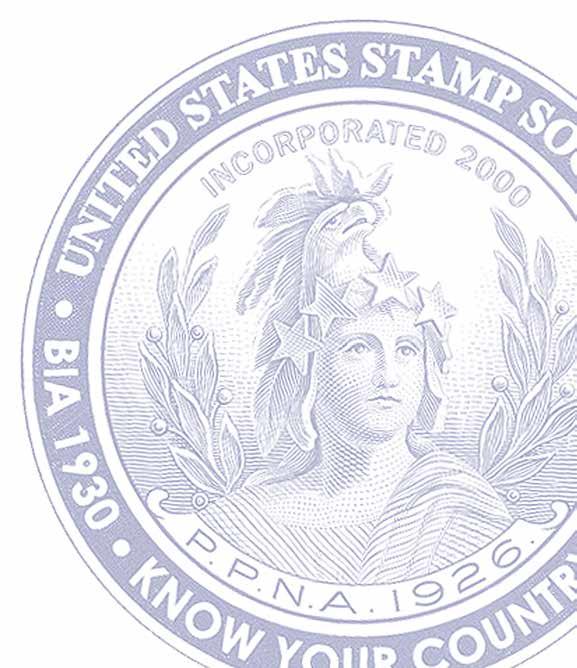
The United States SPECIALIST VOLUME 95, NUMBER 3 MARC H 2024 WHOLE NUMBER 1129 for the Collector of Postage & Revenue Stamp Issues of the United States s plus e Chasing the Dr. David M. Bennett Collection of 1918–20 Offset Issues c and j New Canal Zone Post Office Seal, Lincoln Memorial Private Perforation, & more 1938 Bi-Color Airmail Stamp: FDR, Farley and National Air Mail Week VIAAIR MAIL Honora le Ja~es '. UeaJ. House of Repr-~~ w~tives, Was:1i1.eton , D . C .



 Harry K. Charles, Jr.
Edited by Rodney A. Juell, Lynn R. Batdorf and Steven J. Rod
Harry K. Charles, Jr.
Edited by Rodney A. Juell, Lynn R. Batdorf and Steven J. Rod
Hardbound, 769 pages. $35 members, $40 nonmembers. Visit the website for shipping costs.
Softbound, 253 pages. Postpaid: $25 members, $28 nonmembers. Visit the website for shipping costs.
Order from: USSS, P.O. Box 1602, Hockessin, DE 19707-5602 or online at: www.usstamps.org/store/
United States Stamp Society Publications
Encyclopedia of United States Stamps
Collecting Second Edition
and Stamp
States Savings Stamps
States Savings Stam s h)' Harry K. Churl , p e:-i, Jr , Ph.D
United
by
A presentation of the United States Postal and Treasury Savings Stamp Systems, the stamps and their closely associated collection cards and booklets, and Official Mail stamps and stationery. United
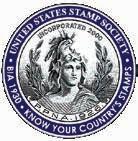
The United States SPECIALIST
the
An association of collectors to promote the study of all postage and revenue stamps and stamped paper of the United States and US-administered areas produced by the Bureau of Engraving and Printing and other contract printers. American Philatelic Society Affiliate No. 150

107
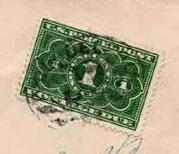
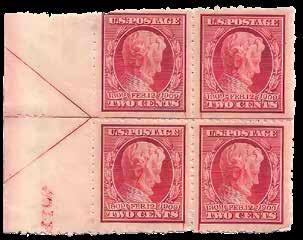
112
113
Andrew S. Kelley, Editor
9038 East 25th Drive
Denver, CO 80238 (720) 839-5848
email: editor@usstamps.org
www.usstamps.org
Manuscripts, publications for review, and all advertising including classifieds, should be sent to the editor at the address above.
Forms close on the 20th of the second month preceding the month of publication, as February 20 for the April edition.
The United States Specialist (ISSN 0164-923X) is published monthly January through December by
Larry S. Weiss

the United States Stamp Society, Inc., P.O. Box 1602, Hockessin, DE 19707-5602. Membership in the United States $25. North America $40; all others $65. Single copy $2. Periodical postage paid at Hockessin, DE, and at additional entry offices. Printed in USA.
Copyright ©2024 United States Stamp Society, Inc. All rights reserved. Opinions expressed by authors are their own and do not necessarily reflect those of the United States Stamp Society, its officers, or staff.
Correspondence concerning business affairs of the Society, including membership and changes in address, should be addressed to the Executive Secretary, PO Box 1602, Hockessin, DE 19707-5602. Postmaster: Send address changes to U.S.S.S., P.O. Box 1602, Hockessin, DE 19707-5602.
journal
VOLUME 95, NUMBER 3 MARCH 2024 WHO LE NUMBER 1129 Features
of the United States Stamp Society
Rolleston Mills Watermarks on Post Office Seals by Gary B. Weiss and Jeff Renholts
Large Envelope Company Used Sewing Machine To Roulette 1909 Imperf Lincoln by Kevin
Lowther
G.
Unusual Use of Parcel Post Postage Due Stamps from 1913 by Michael
1938 Bi- Color Airmail Stamp: FDR, Farley and National Air Mail Week,
I by
Chasing the Dr. David M. Bennett Collection of 1918–20 Offset Issues by
Prologue 99 Membership Anniversary Pins 101 Closed Albums 102 Letters to the Editor 104 Donors 110 Vintage Photo of the Month by R odney A. Juell Epilogue 140 Plate Number Report by Kim D. Johnson 142 E xecutive Secretary’s Report by R obert Rufe 144 Classified Advertising 144 Index of Advertisers
Mll//J43
Wilson 115
Part
Paul M. Holland. 127
R(@!ll/re£Jilollfl

The United States Specialist
Founded 1930 as The Bureau Specialist
EDITOR
ANDREW S. KELLEY
9038 East 25th Drive
Denver, CO 80238
email: editor@usstamps.org
United States Stamp Society Bureau Issues Association, Inc.
P.O. Box 1602
Hockessin, DE 19707-5602
CHAIRMAN
Roger S. Brody
P.O. Box 5836
Somerset, NJ 08875-5836
email: brody@usstamps.org
PRESIDENT
Nicholas Lombardi
P.O. Box 1005
Mountainside, NJ 07092
email: 8605@comcast.net
VICE PRESIDENT
Jeffrey Shapiro
P.O. Box 3211
Fayville, MA 01745-3211
email: coverlover@gmail.com
SECRETARY
Joel Cohen
10703 Kings Riding Way, Unit T-1 Rockville, MD 20852-5420
email: cohenji@comcast.net
TREASURER
David S. Sugar
4045 N. Harvard Ave. Arlington Heights, IL 60004
email: david-sugar@wsdd.com
GOVERNORS
Lynn Batdorf
Kim Johnson
Mike Lampson
Leonard Piszkiewicz
James Robinson
Robert Rose
Rod Juell
Gregory Shoults
David Steidley
Jay Stotts
Steven Unkrich
EXECUTIVE SECRETARY
Robert Rufe
P.O. Box 1602
Hockessin, DE 19707-5602
email: execsecretary@usstamps.org
— Committees — AWARDS
Denise Stotts
P.O. Box 690042, Houston, TX 77269
email: stottsjd@swbell.net
BOOKLETS & BOOKLET PANES
Michael O. Perry
P.O. Box 1194, Rainier, OR 97048
email: MOPerry@mac.com
DURLAND EDITOR
Kim D. Johnson
310 E N 3rd Street, Georgetown, IL 61846
email: westhome1@aol.com
ESSAY-PROOF
James Patterson
1850 North Central Avenue, No. 1400 Phoenix, AZ 85004
email: jhpatterson@yahoo.com
EXHIBIT PDFs
Chris Steenerson
P.O. Box 1818
Westminster, CO 80038-1818
email: Chris@RxStamps.com
FARLEY ERA
Paul M. Holland
email: pholland.thorleaf@gmail.com
FOURTH BUREAU ISSUE
Jay B. Stotts
P.O. Box 690042, Houston, TX 77269
LIBERTY SERIES
Roland Austin
P.O. Box 2641, Stillwater, OK 74076-2641
email: RAustin13@aol.com
MARGINAL MARKINGS
Chris Steenerson
P.O. Box 1818
Westminster, CO 80038-1818
email: Chris@RxStamps.com
MODERN POSTAL HISTORY
Douglas B. Quine
P.O. Box 153, Bethel, CT 06801-0153
email: usss2010@quine.org
PLATE NUMBER & CHECKLIST SERVICE
Kim D. Johnson
310 E N 3rd Street, Georgetown, IL 61846
email: westhome1@aol.com
PRECANCELS
Lynn R. Batdorf
6005 Kingsford Road, Bethesda, MD 20817
email: hollykids@comcast.net
PRESIDENTIAL ERA
Jeffrey Shapiro
P.O. Box 3211, Fayville, MA 01745-3211
RECRUITING
Steven Crippe
P.O. Box 308, Palmer, TX 75152
email: scrippe@gmail.com
REVENUE ISSUES
Peter Martin
P.O. Box 6074, Fredericksburg, VA 22403
email: pmartin2525@yahoo.com
SECOND BUREAU ISSUE
Nicholas Lombardi
P.O. Box 1005, Mountainside, NJ 07092
VENDING AND AFFIXING MACHINE PERFORATIONS
Dan Ryterband
40 Carolyn Place, Chappaqua, NY 10514
email: djryterband@fwcook.com
WASHINGTON-FRANKLIN
HEAD ISSUES (Co-Chairmen)
Greg Shoults
11248 Frederick Lane Twinsburg, OH 44087
email: coilcollector@hotmail.com
Andrew S. Kelley
9038 E 25th Dr, Denver, CO 80238
email: stamps@andrewkelley.net
WEBMASTER
Mike Lampson
P.O. Box 471963, Charlotte, NC 28247
email: lampson@usstamps.org
— Study Groups —
DUMMY STAMPS
Terry R. Scott
P.O. Box 10406, Napa, CA 94581
email: terryrscott@comcast.net
FIRST BUREAU ISSUE
Kent Wilson
1005 Toole Circle, Billings, MT 59105
email: turgon96@bresnan.net
LUMINESCENCE
Wayne L. Youngblood
705 Forest Glen Circle, Prairie du Sac WI 53578
email: wystamps@gmail.com
OVERRUN COUNTRIES SERIES
Thomas Schilling
P.O. Box 432, New Lisbon, NJ 08064-0432
email: cbtkschilling@yahoo.com
PROMINENT AMERICANS AND AMERICANA SERIES
Ron Blanks
email: rblanks_stamps@yahoo.com
REGISTERED MAIL
Mike Ludeman
P.O. Box 2024, Denton, Texas 76202-2024
email: mike@ludeman.net
— Affiliates — POSTAL LABEL STUDY GROUP
Arthur H Groten M.D.
PO Box 3366, Poughkeepsie, NY 12603
email: artgroten@optonline.net
98 THE UNITED STATES SPECIALIST

2024 USSS Membership Anniversary Pins
The Society wishes to congratulate the following loyal members who have attained milestone anniversaries during 2024:
50 Year Members
Charlie Austin
Jim E. Leischow
James Bateman
J. Roy Bolin
Michael F. Burke
Geoff Dutton
Michael D. Hancox
Michael Jaffe
Brian J. Baba
Stephen Banks
Dr. Steven J. Berlin
Barbara Bilson
Andrew J. Burkman
Jeffrey M. Coney
Robert G. Coradi
H. Denny Donnell Jr. MD
Ann Dunkin
Steve Levine
Herbert S. Loring
25 Year Members
Matthew Kewriga
Mike Lampson
Ronald S. Levy
Charles Miller
Daniel Nieuwlandt
O.R. Olson
15 Year Members
Nathan Esbeck
Ted Gifford
Dave Gill
James A. Ginsburg
Vicky Hadley
Dave Hamilton
Scott L. Hoffman
Dave Horton
S. Jacobson
Robert Mittelstaedt
Michael O. Perry
Lee J. Storhaug
Ronald E. Strawser
Steven G. Thomson
Ross Towle
Warren L. Kellner
Steve McCarthy
Scott Murphy
Ronald J. Stauber
Kunihiko Tamura
Robert E. Thompson
David Thompson
Jack Van Ens
John Zwyer
If you are a member of one of these anniversary groups, we would like to give you your pin at the Great American Stamp Show in Hartford in August or at our 2024 Annual Meeting, which will be held at NOJEX in September. If you are unable to attend either of these shows, your pin will be mailed to you in the fall.
Again, thanks for your loyal support of the United States Stamp Society.
—Nick Lombardi, President
MARCH 2024 99 Society News
A Compendium of Plate Number Coil SNIPPETS
by Alan Thomson
An Incredible collection of 109 installments chronicling the monthly highlights, developments, and discoveries of Plate Number Coils (PNCs) from October 1993 to April 2004
▪ A valuable resource about the stamps, important finds, and the people involved in the PNC stamp collecting specialty during this dynamic period in USA stamp history
▪ 170 pages updated with more than 50% color images of the original material
▪ Easy-to-use reference with a comprehensive index organized by stamps, series, and topics
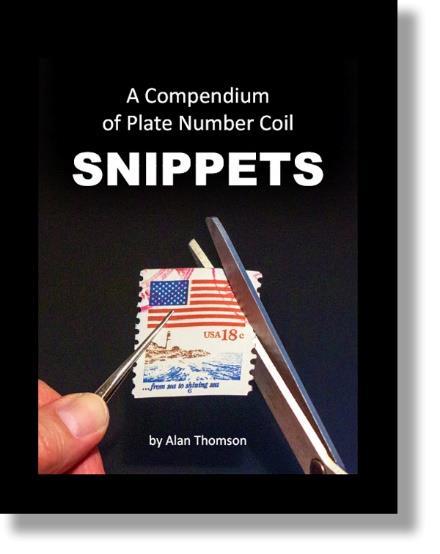

Available from Amazon.com in hardcover and paperback editions

This compendium of all 109 installments of SNIPPETS forms an indispensable chronologic record of a dynamic period of coil stamp production and PNC collecting. Its pages document the waning years of the Transportation Series, trace the introduction of self-adhesive coil stamps and die cutting, and the transition of coil stamp production from the Bureau of Engraving and Printing (BEP) to the private stamp printers. Additionally, many of the original black-and-white images that documented the new discoveries and illustrated the varieties have been replaced with color images for improved clarity.
Whether you are reading SNIPPETS for the first time or are re-reading it from when it was first published in Coil Line almost 20 years ago, you will find this compendium an indispensable information guide and long -term reference that will add to your enjoyment of collecting PNCs.
Fully indexed — Now includes color images of many of the original stamps!
•JoRI SS l l'J>ETS 1111oo.eca,a,,.... _"'.. -·..... _....,_ ... ----,--..----.u, -----·---·-::.-::::::::.:.~~....::..:= .... -~----...... -_......,......,.................. _____ ... ____ _ ..,--~----! __, - -~1--•-_............ ~....,-011e__ ..,_...,,...,,_. ___ _ c,.-.,__ .,_.,, ..,__. =~::-.=;.:.-::~~ ---· ..-.-•1•---..__01z:.;F:!Sr?L=.:: --~...----order on amazon '--, .;1

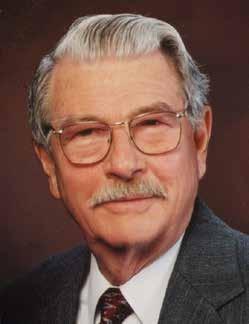
Alan Thomson
1931–2024
Alan Thomson peacefully passed away at his home in Northwood, New Hampshire, on January 3, 2024, with his two sons by his side. Alan was 92 years of age.
Alan Thomson was an accomplished philatelist who collected all US stamps from the classics to modern issues. He had a special interest in stamp production methods and how changes in production processes or technology affect the final stamp products—from the individual stamp to a full sheet, coil, or booklet of stamps.
Alan was an active member of several philatelic organizations, including the American Philatelic Society, the United States Stamp Society, and the Plate Number Coil Collectors Club (PNC3). In addition to contributing many articles to philatelic publications such as The Plate Number and Coil Line (monthly journal of PNC3), Alan served as Distribution Agent for PNC3 for 17 years and, for more than 16 years, was Coordinator for Coil Stamps issued after 1980 for the recurring “Plate Number Report” in The United States Specialist. Alan had also provided annual editorial reviews of post-1980 coil stamps included in Scott’s Specialized Catalogue of United States Stamps & Covers, starting in 1997.
Like many other stamp collectors, Alan’s interest in stamps started in his youth, but he left the hobby at the age of 12—only to return to philately with a passion as an adult.
Alan grew up in Palo Alto, California, and graduated from Palo Alto High School in 1950. Rather than walk across the highway (EI Camino Real) and go to Stanford University, he chose to cross San Francisco Bay and attend the University of California, Berkeley. It was there that he met and married his wonderful wife of 65 years.
At his graduation from U.C. Berkeley, Alan received his diploma and a commission in the United States Air Force. Shortly thereafter, Alan entered active duty, went through pilot training, and began a 22-year career flying Uncle Sam’s aircraft. Alan graduated from flight school as a fighter pilot and ultimately flew every type of aircraft in the Air Force inventory, including the B-47 Stratojet nuclear bomber, which Alan piloted for many years. Alan retired from the Air Force with the rank of Lieutenant Colonel.
When Alan returned from Vietnam in 1970, he went to a local post office to buy postage and was drawn back into philately when four se-tenet stamps caught his eye. His collecting of single stamps quickly escalated into plate blocks and eventually plate number coils in the early 1980s. The start of the dynamic period in US stamp production that coincided with the appearance of PNCs was a boon to Alan’s keen interests in stamp production varieties. The result of this overlap was Alan’s informative SNIPPETS column in the monthly issues of Coil Line that spanned more than a decade.
MARCH 2024 101 Closed Album
Alan Thomson

Regarding “Curious Information”,
February 2024, p. 68.
I received my copy of the Specialist today and have at least a partial answer as to the postage.
The maximum height for a letter is 6 1/8". The Christmas card shown is a “large envelope.” Because the item is not dated, I presume the Forever stamp is valued at 66¢ for a total value of $1.06 in affixed postage.
The current rate for a one ounce large envelope is $1.39. I don’t know last year’s rate but I am sure it was over $1.06.
I suspect somewhere down the line someone recognized that the envelope was short paid. Instead of marking it “returned for additional postage” and indicating the difference (with a hand stamp) they used a peelable label that was handy, writing in an incorrect total.
I have found on several occasions that, as a stamp collector, I know more about stamps and postal rates than the people working the counters.
The solution would have been to use the postage calculator at www.usps.com to determine the correct postage in advance

and to ask the window clerk for a hand cancel. The envelope would have been put in the appropriate tub with an even money chance of getting a machine cancel along the way, but with the hand cancel it may have been enough to avoid further scrutiny.
I hope I’ve answered part of the question although I doubt I’m the first reply.
James Natale USSS 12629
Curious indeed, this episode seems almost a perfect storm of mis-steps, both avoidable and perhaps unavoidable. Also present are a touch of mystery, and an example of how plain English can be imprecise in what it means to convey.
With the envelope’s stated size of 6 3/8" height, it is not a “letter” shape by the shape-based pricing of first-class mail introduced in May 2007. Our letters nowadays are capped at 6 1/8" height.
(The Postal Service’s Notice 123 “Price List” details all the current postage rates and fees for retail and commercial mailings. The online version, available at pe.usps. com/text/dmm300/Notice123.htm, has a nice two-page spread of shapes, sizes, and prices to start its “Quick ReferenceDomestic” section, page 89–90 in the January 21, 2024 version.)
So off the bat, the Christmas greeting is a Large Envelope shape, which started at $1.35 for one ounce when mailed in December 2023. Interestingly, the two 20-cent stamps confirmed as “plenty” of additional postage needed, equaled only the 40¢ nonmachinable surcharge then in effect only for letters.
Perhaps the busyness of the Christmas mailing season mildly flustered the post
102 THE UNITED STATES SPECIALIST Letters to the Editor
Cover bearing the “curious information” referred to in the original article.
..
office personnel? Consider they have seen over the years a stream of retail postal patrons who have greeting card envelopes “conforming” as letters, but nonmachinable because they are “square” shaped.
The scribbled “$1.59 Due = 2 oz. Large Envelope Rate” onto an applied sticky label is notable in several respects. We have a mystery as to how two ounces was determined, in light of the last sentence of Mr. Gregory’s first paragraph:
“The Postmaster weighed and sized the envelope before sending it, so I assumed the postage I applied was sufficient.” I first assumed this meant the postmaster had weighed the envelope again after two commemorative-sized stamps were added.
But I suspect the quote is referring only to tasks prior to adding more stamps, namely the initial evaluation when Mr. Gregory presented the mailpiece. Mr. Gregory can correct me, but it seems sizing the envelope would only be needed once, yet no hand cancel was applied. Did “sending it” occur at the counter, after applying 20¢ stamps from his pocket? Or did he go home to add 20¢ stamps and then drop envelope in collection box or leave it for carrier pickup?
The actions sequenced above might speak to the mystery of one versus two ounces. A common scenario has collected mail dumped into the hopper at a regional postal plant, where oversized envelopes are culled when they fail to pass through the sizing mechanism.
Someone checks the mail that is now considered not “letters,” and may have decided the envelope weighs two ounces. Did the first postmaster use a digital scale to arrive at one ounce, because the item really did not exceed one ounce and the scale was perfectly calibrated?
(What about a contrary case, with 1.05 ounces weight passed as one?)
Consider also if the item really weighed a full one ounce, and its second weighing later as a “large envelope” was on a scale not so calibrated; hence, a twoounce reading. What about the two added stamps, not part of the first weighing? Did they “tip the scales?”
The applied label itself is almost self-explanatory. With such a long hand-written message during a busy processing tour, and none of the printed reasons applying, it seems a contingency use in a hurry. The important parts were the pointing hand for later handling, and “Return for Postage.” In such case, we can fault the harried worker with simply not marking through the non-reasons.
For those who have seen many an auxiliary marking, contingency uses of labels for other purposes, and striking through non-reasons, are not uncommon. Some handstamps in fact have a list of return reasons with check-off boxes for marking the actual cause.
Ron Blanks USSS 17087
Send your letter to the editor via email to editor@usstamps.org. You may also mail your letter to The US Specialist, 9038 East 25th Dr., Denver CO 80238.
2024 HEBERT’S
All New and Revised
Mint and Used Plate Number
Single Catalogue $36 postpaid
Expanded pricing, back-of-the-book, tag/paper varieties, PN/ZIP/ME types
P.O.
Palatine, IL 60078-1023
MARCH 2024 103
APNSS
Rick Burdsall /
Box 1023

Contributor Recognition
We gratefully acknowledge the following members who supported our Society during the 2024 dues cycle by making donations in excess of their annual $25 dues. All such donations are appreciated, and greatly enable the Society’s work.
Regular Members
donations of up to $29
Anonymous
Marc Achterhof
Peter A. Amster
Thomas Anderson
Roland Austin
Larry Ballantyne
Joseph C. Banchak
Ronald L. Beck
Joseph J. Becker
James Belcher
Bob Bialo
John Bishop
Stephen Breitkopf
Albert Briggs
Randy Broda
Stephen J. Bukowy
Alfred Carroccia
Carl F. Cerco
John O. Christiansen Jr.
James Clark
Robert J. Courdway
Roger D. Curran
Glen J. DeSalvo
Richard Diskin
David Dohrmann
Beth Dukatz
Donna Eversole
William Fennell
Roger Fury
Dalton Hoffman Jr.
Gene M. Holgate
Paul J. Hopkins
S. Jacobson
Clifford Krinsky
Keith Lichtman
Edwin H. Lugowski Jr.
Robert E. Lynch
Keith Maatman
Michael Manthe
Lewis B. McCammon III
Manes Merrit
Robert Mis
Richard Pederson
Andrew D. Pitonyak
Marvin Platt
George F. Pollock Jr.
Joseph C. Reymer
Peter Rikard
Reed Roholt
Ken Sawyer
Eugene Setwyn
John S Shue
David Sieroty
Jeffery T. Sigler
Martin Skrocki
Mark J. Smith
Patrick Buck Smithson
Spencer Snow
Dennis Solheim
Herbert C. Spomer
Lee J. Storhaug
Stephen Suffet
Alan H. Thomson
Steven G. Thomson
James D. Trenchard
Carol Anne Visalli
Robert D Wark
Betty Westfall
Cale Whitehouse
Kirby E. Willems
Robert P. Wollert
Sustaining Members
donations of $30 or more
Anonymous
Joan Anderson
Richard Andrews
Paul W Anthony
Robert Baum
Dr. Steven J. Berlin
Cameron Betts
Barbara Bilson
John M. Bleecker Jr.
John H. Bloor MD
Michael Borut
Bob Boynton
Gordon C. Bradwell
Harry G. Brittain
Stephen Chilton
Victor Collinino
John Cowan
K. Clarke Crandell
David A. Dean
Howard F. Dey
Paul Donovan
David L. DuBois
Ann Dunkin
David S Durbin
Jere Dutt
Allan B. Elkowitz
Richard Emanuel
Dr. John Farrer
Edward Field
Mark Flynn
Owen Ford
Trevor Fried
Dr. Charles R. Gherman
Charles C. Gilbert III
Gary Gilliland
104 THE UNITED STATES SPECIALIST
Stephen J. Goceliak
Albert N. Gore Jr.
Martin D. Green
George Guerra
Lawrence Haber
Daniel Hallstrom
John Hamman
Charles Hansen
Charles W. Herren
Eloise Hintersteiner
Peter F Hoffman
Robert Hohertz
Dave Horton
John Howker
Richard B. Hunter
Thomas M. Jacks
Michael Jaffe
Greg Johnson
Larry B. Johnson
Kent L. Johnston
Kevin Keane
Brian Keller
Joseph Kelley
Annamary Kennell
Kurt Kiesling
Carl M. Knudsen
Keith Knutson
Leon Komkov
Leonard Kortekaas
Jeffrey L. Kushner
Benjamin Y. Lee
Daniel Lind
Lawrence A. Lindquist, Jr.
Ralph E. Lott
Henri J. Mackor
James MacLellan
David W. Marino
Charles C. Marshall
William Matthews
James McAndrew
Steve McCarthy
Gary W. McClarran
Bill McCloskey
William McGill
David E. McGuire
Douglas McNicol
Arlene Merves
Clifford A. Mestel
Eric Meyermans
Gerald Michels
J. Bruce Miller
Martin Miller
Thomas Molchan
Jim Morris
David Mower
Rodolfo C. Narvaez
John Nocchiero
Glen Norman
Marshall Northington
Gary Olson
James C. Opp
Robert Peck
Charles Van Pelt
Gaylon Pemberton
James R. Perry
Richard Peterson
Brad Peterson
Robert L. Pettinato
Thomas J. Piper
Jack Place
David Porch
William H. Powell III
Robert Preston
Chris Principe
David J. Reedy
David J. Regan Jr.
James S. Robinson
Margaret Rowles
Col. Robert F. Schlegel Jr.
Robert Schlesinger
Fred J. Schmitz
Judson Schultz
Joseph F. Serota MD
Lawrence Sherman
William Sihler
Albert Smith
Carl Smith
James A. Sorenson
Glenn Specking
John A. Steele
Henry-York Steiner
Scott Steward
Samuel J. Stratton
Ronald E. Strawser
Robert Stuck
Richard A. Thalheim Jr.
Richard Toebe
John Ur
Larry Walling
David B. Wenzelman
David Willig
Bernard Wojnowski
Richard M. Wrona
Elizabeth Yee-Hess
John M. Young
Richard Zane
Max E. Zollner
Contributing Members
donations of $50 or more Anonymous
Greg M. Ajamian
Steven Altman
Jack Andersen
Joseph Arsenault
Gary A. Baker
Larry D. Barnes
Richard Bendix
Richard Bielefield
Lyle C. Boardman
Randall M. Brooksbank
Thomas Brown
Andrew J. Burkman
Arthur Bussiere
Dennis Callison
Francis Caprio
Jackson L. Case
Eric E. Chaulsett
Dennis Cipollo
Randy M. Collins
Charles E. Compton
Ron Couchot
Frederick E. Coveler
Dennis Dajczak
Anthony F. Dewey
MARCH 2024 105
Raymond Doberneck MD
Dr. Donald R. Dolan Jr.
John Patrick Duffy
Geoff Dutton
Andrea S. Edmondson
Craig Eggleston
Gordon Eubanks
James P. Ferrigno
John Fluke
David R. Fredericks
Charles Freise
Ralph Freudenthal
Dr. Richard Friedberg
Cheryl Ganz
Jan Garfinkel
Ray Getsug
Donald Getzin
Charles G. Groneman
Jeffrey M. Haeberlin
Dave Hamilton
Michael Hancox
James Helm
John Hightower
Elizabeth Hisey
Robert Holcomb
David F. Hull
Morris E. Jacobs
Paul Jenkins
Arthur Lafionatis
Mike Lampson
James E. Lee
Jim Leischow
Michael McCollum
Gary L. Mueller MD
Joseph Napp
Christopher A Nardo
Kenneth R. Nilsestuen
David Joseph Novak
Charles J. O’Brien
Scott Pendleton
Sheldon R. Phinney
Leonard Piszkiewicz
Edward Pulse Jr.
Steven V. Reeder
Steven E. Rewerts
Thomas S. Richardson
Jay Rinehart
Peter Rogge
Alexander J. Savakis
Gary L. Schwieger
Terry R. Scott
Craig Selig
Randall J. Smith
Harold Sollenberger
Salvatore Spagnola
Richard Spector
Robert J. Sperberg
Patricia Stennett
Brian Stockman
Jay B. Stotts
James R. Stultz
David Sugar
Hank Thode
Blair Tremere
Charles W. Troutman
Michael S. Turrini
Peter Tuteur
George Vitak
Richard C. White
Loyal Wiens
Robert B. Wilson
Patron Members
donations of $95 or more Anonymous
Lynn R. Batdorf
Eric S. Borsting
Roger Brody
Lewis Burchett
Michael F. Burke
Todd Caron
Charles E. Chambers
Harry K. Charles Jr.
David Cogar
Charles Compton
Ronald J. De Haas
W.
Douglas Drumheller
C. David Eeles
Richard J. Faller
Gerald Forsythe
Richard T. Garner
Richard Gottron
Edward Grabowski
Eben W. Graves
Carlin Gregory
Douglas Horka
Jay Joyce
William Kolodrubetz
James E. Krome
Donald R. Kurki
David Lane
David W. Lentz
Nicholas A. Lombardi
Edward A. Martin
Evan Matthews
Thomas McFarland
Ralph Nafziger
Charles Neyhart
Harold Nogle
Scott Payton
James H. Peterson
Thomas H Phillips
Thomas Pollard
David A. Reyno
Patrick W. Rice
Robert Riethe
Robert G. Rose
Robert G. Rufe
Daniel Ryterband
Wade E. Saadi
Phil M. Sager
R Gordon Schmidt
Ralph F. Schrack Jr
Kim R. Schroeder
Scott A. Shaulis
John B. Shely
Tom Spina
Craig J. Stowers
Donald J. Sundman
David Swinford
Mark W. Taylor
Robert G. Thompson
Robert Thompson
Thomas L. Thorbahn
Wilfred L. Thornthwaite
John W. Wagner
Rudolph Waranka
Michael Wilson
106 THE UNITED STATES SPECIALIST

Rolleston Mills Watermarks on Post Office Seals
by Gary B. Weiss USSS #13373 | m garybweiss@aol.com
and Jeff Renholts m jrenholts@mac.com
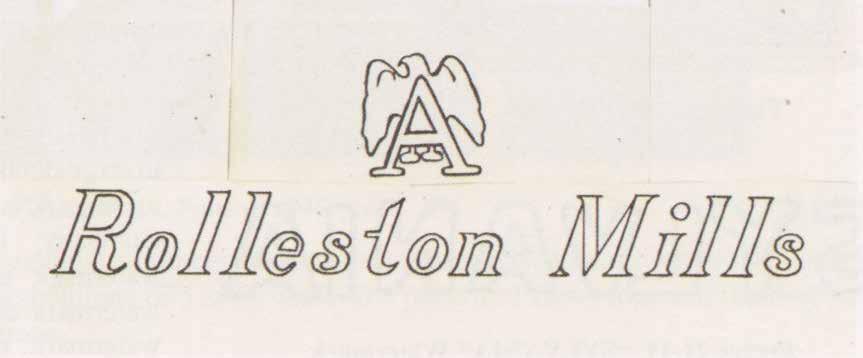
A newly discovered Canal Zone post office seal1 may also lead to important changes in the listings of US post office seals. The newly-discovered seals also feature a different spacing between subjects than previously reported.
A Rolleston Mills watermark is known on both US (Figure 1) and Canal Zone post office seals. Perkal and Kazman describe and illustrate the watermark. “It is composed of the words ‘ROLLESTON MILLS’ in 2 mm [sic] high, double-lined italic letters. Above the word ‘ROLLESTON ’ is also found the emblem of the American Writing Paper Company, an eagle surmounting the letter ‘A.’ This emblem was in use from 1911 to 1976, so we can safely assume that this watermark did not make its appearance until 1911 or 1912.”2 Their illustration shows the writing of “Rolleston Mills” to be in both upper and lower case letters.
The watermark on Canal Zone seals is described by Plass et al. as being in “large double-lined capital letters about 16 mm tall…The watermark reads vertically.”3 In contrast, Kotanchik describes the letters as 21 mm tall, his illustration shows upper and lower case letters, and he also notes that it always reads vertically.4 Kotanchik also dates these watermarks to 1907. In looking at our holdings of Scott No. OX2a, all of our watermarks (Figure 2) match the Plass description (upper case letters) and not the
MARCH 2024 107
Post Office Seals
Figure 1. Rolleston Mills watermark.
M lIlll!
R@ll11.@ 1@llJl
&
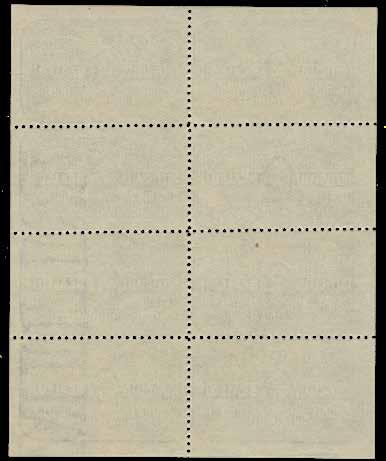
Kotanchik description (upper and lower case letters). Kotanchik concludes that “The presence of the (same) watermark, and their spacing is strong evidence that the same paper stock was used for both the US and Canal Zone seals. The difference in perforation is somewhat surprising.” Obviously, this no longer provides evidence that the same paper stock from the American Writing Paper Company was routinely used for both US and Canal Zone seals. The descriptions of the two watermarks in the Scott Specialized Catalog are identical: “Wmkd. ‘Rolleston Mills’.”5
Until now, there was little importance to our observation that two distinct watermarks appear to have been used for the US and Canal Zone post office seals. Even though the evidence Kotanchik presented for his conclusion was wrong, his conclusion could still be correct. A recent discovery may make this observation more important; a pane of eight Canal Zone post office seals was found with not only the US Rolleston Mills watermark (Figure 3) but also a previously unreported setting of the pane in terms of the spacings between the seals.1 This item represents a distinct (new) Canal Zone post office seal and adds an empty space to almost all Canal Zone collections. Canal Zone collectors have rarely needed to study the watermarks in their collection. The only watermarked stamps are Canal Zone Scott Nos. 4–8 and J1–3; as all are watermarked, there is no need to check these stamps for watermarks. Modern

108 THE UNITED STATES SPECIALIST
Figure 2. Vertical, upper case Rolleston Mills watermark on Scott OX2a.
,. · ! • • •• • •. ••• •••••• •C•• ••••• •••• ••. •• ·• •••••• ... .... .... ... ....... .. .;........................
Figure 3. Newly discovered canal zone post office seals with Rolleston Mills watermark.
Canal Zone postal stationery often has watermarks but these are best distinguished by holding the envelope up to the light. Watermarks on the Canal Zone seals when limited to the US shield watermark and the Rolleston Mills watermark were easily identified simply by holding the seal to the light. The Canal Zone collector dipped stamps only to look for flaws. Now with two distinct watermarks on the Canal Zone seals, careful examination, perhaps using a watermark tray, may be needed more often. All Canal Zone seals with the Rolleston Mills watermark should be reexamined to determine which type of watermark they have.
Perhaps more importantly, the US seals with known Rolleston Mills watermarks (OX12b, OX13b, OX14b, and OX16b) also need to be reexamined. New varieties with the watermark in all capitals may be out there waiting to be found.
References
1. Jeff Renholts and Gary B. Weiss, The Canal Zone Philatelist, Volume 60, in preparation, 2024.
2. The Post Office Seals of the United States: Volume One: The Regular Issues by Adam Perkal and Seymour Kazman, 1983, pages 82 and 84.
Quality United States Stamps (1847-1945)
Singles (mint and used)
Plate Blocks
Booklet Panes plus Complete Booklets
Price lists-$2.00 each category
Price lists free on web: www.mountainsidestampsandcoins.com

We also buy quality U.S. and foreign stamps
Mountainside Stamps, Coins and Currency
P. O. Box 1116
Mountainside, NJ 07092
Tel: 908-232-0539 or 908-419-9751
E-mail: tjacks@verizon.net
Tom Jacks, owner Member APS, ASDA, USSS
3. Canal Zone Stamps by Gilbert N. Plass, Geoffrey Brewster and Richard H. Salz, 1986, page 295.
4. Post Office Seals of the United States and Possessions by Jim Kotanchik, 2006, pages 135–139, 285.
5. Scott Specialized Catalogue of United State Stamps & Covers, 2021, pages 1021 and 1120.
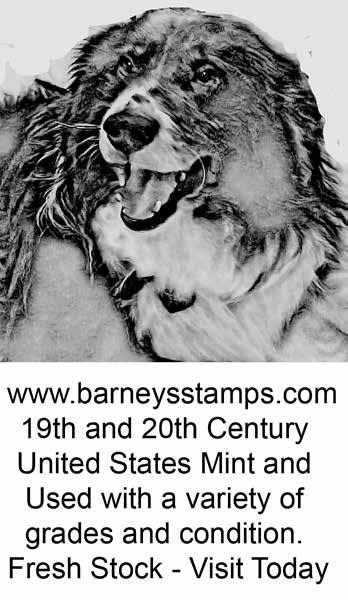
MARCH 2024 109
www.barneysstamps.com 19th and 20th Century United States Mint and Used with a variety of grades and condition. Fresh Stock - Visit Today

 by
A. Juell
by
A. Juell

110 THE UNITED STATES SPECIALIST
Vintage
Photo of the Month
Rodney
USSS #13852 | P.O. Box 3508, Joliet, IL 60434
P-80 Shooting Star—First Jet Air Mail
This month’s photo was taken at an air show in Schenectady, New York in 1946, at which General Electric Company showcased its aviation products. The aircraft shown in the picture are the Lockheed P-80 Shooting Star jets. On June 22 these jets carried air mail from Schenectady to Washington, DC, and Chicago, and on demonstration flights over the Schenectady area. This was the first time that jet aircraft were used to carry mail. Shown nearby is a cover carried on one of these flights.
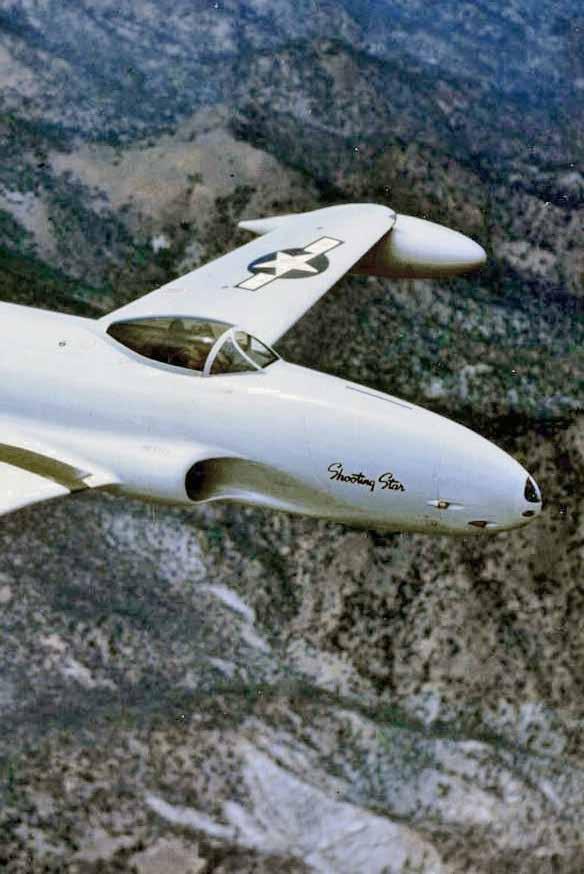
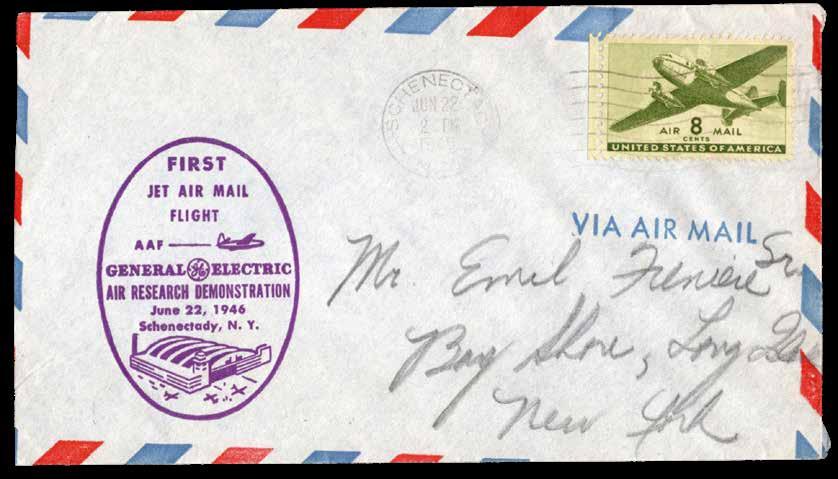
MARCH 2024 111
IRST ET AIR MAI FLIGHT AAP-~ NBUL@BI.B RESUICII IDJONSTRA June 22 , 1946 Schenectady, N Y• ~,, ,• !Ilk _ - 4 AIR 8 MAIL Ii Uii

Large Envelope Company Used Sewing Machine To Roulette 1909 Imperf Lincoln
by Kevin G. Lowther USSS #14367 | m klowther5@gmail.com
The late Melvin L. Getlan’s vast collection of vending and affixing machine perforations and related material included several 1909 Lincoln imperforate commemoratives (Scott 368), mostly in blocks, which had been rouletted on a sewing machine. The rouletting was labeled as of “unknown origin.” Figure 1 shows a mint rouletted arrow block of four from Getlan’s collection.
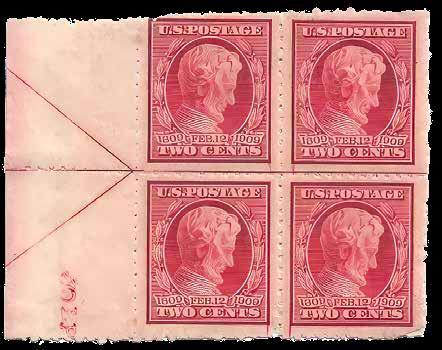
While recently combing through publications of C. H. Mekeel, circa 1910, I stumbled across a brief story, headlined “Other Unofficial Perforations,” in an undated issue of Mekeel’s News and Trade Circular, which the St. Louis dealer sent to clients. Mekeel devoted considerable space to illustrating what were being called “part perfs.” His story on “unofficial”perfs read in part:
A ‘sewing machine perforation’ applied to the 2c Lincoln, is used exclusively by a large envelope manufacturing concern, who attach adhesive stamps to their envelopes in large quantities which are then supplied in competition with government stamped envelopes. Used copies of the 2c Lincoln, with the ‘sewing machine perforations,’ have been called to our attention by several correspondents.
All of Getlan’s examples of Scott 368 are mint. Collectors should watch for covers franked with the rouletted variety.
112 THE UNITED STATES SPECIALIST
Private Perforations
Figure 1. Sewing machine roulette applied to Scott 368 by an unnamed “large envelope manufacturing concern.”

Unusual Use of Parcel Post Postage Due Stamps from 1913
by Michael Wilson USSS 17371 | m mwilson34407@gmail.com

In late 1912, the Post Office issued a set of 12 parcel post stamps with denominations ranging from one cent to one dollar. The Post Office also issued five parcel post postage due stamps with denominations ranging from one cent to 25 cents. Starting January 1, 1913, these stamps were to be used exclusively on fourth-class mail weighing four ounces or more. Other stamps could not be used on parcel post after that date.
That exclusivity did not last long, however. Effective July 1, 1913, the Post Office decreed that regular postage stamps would be valid on parcels, and from that point forward, parcel post stamps—including the postage due varieties—became usable as regular stamps. Parcel post stamps remained on sale, but no further printings were made.
These two covers provide examples of the one-cent and two-cent parcel post postage dues used on regular mail. The Scott catalog lists these as JQ1 and JQ2, respectively.
The cover depicted in Figure 1 was mailed from Portage, Pennsylvania on September 30, 1913. It was a first-class letter, thus requiring two cents postage. Since just one cent postage was affixed in the form of Scott 405 (probably a single from a booklet pane, thus Scott 405b), the letter was forwarded with one cent postage due. Since the post office probably did not have any regular postage due stamps in stock (at the time, that would
MARCH 2024 113
Postal History
Figure 1. Scott JQ1, a parcel postage due stamp, reflecting payment of one cent postage due on a shortpaid first class cover.
been Scott J45), the postal clerk affixed the one cent parcel post postage due stamp, a perfectly legitimate move.
Who sent this letter from Portage, which is about 240 miles due west of Philadelphia, is unknown. I cannot find much information on the recipient, Miss Golde Rosenburg. There was someone by that name born in Philadelphia 1906, but other than a birth certificate, there are no further records of an individual by that name in Philadelphia.
German Hospital, however, continues in operation to this day. It is known as Lankenau Medical Center and is one of the top five hospitals in the Philadelphia region. It was founded in 1860 as the German Hospital of Philadelphia and served primarily German-speaking residents and immigrants. With the entry of the United States into World War I in 1917, it was renamed Lankenau Hospital.

The second example shown in Figure 2 was postmarked in Kansas City, Missouri on September 4, 1913. Two cents postage was paid with Scott 406 but given that it was a number 10-size envelope and contained correspondence from one attorney to another, it probably weighed more than one ounce, thus requiring 2-cents of additional postage. That overage was covered by affixing the parcel post postage due stamp that is number JQ2 in the Scott Catalog.
The sender was Charles M. Bush (1876–1936), a prominent Kansas City attorney. The recipient was Silas Bullard (1841–1922), who during his career was an attorney, judge,
The U.S. Philatelic Classics Society is a not-for-profit collector organization exclusively devoted to 19th century United States stamps and postal history. Our quarterly Chronicle is widely recognized for presenting new scholarship and discoveries. For membership information and much more, find us at: www.uspcs.org.

114 THE UNITED STATES SPECIALIST
Figure 2. Scott JQ2, a parcel postage due stamp, reflecting payment of postage due on a double-weight first class cover.
0 H A S. M". B O H ,IT t.. l'-~¥2 _...... _....
====211 --- ---= .
El- . Silu Jlul.larll, Attorne, ct Law, llenaeha , Irie ,

From the Farley Era Committee
1938 Bi-Color Airmail Stamp: FDR, Farley and National Air Mail Week, Part I
by Paul M. Holland USSS #16849 | m pholland.thorleaf@gmail.com

“It is a pleasure to send you this letter bearing the postage in the form of a bi-colored 6-cent air-mail stamp, which has been authorized in more distinctive design to replace the stamp heretofore available.
This letter is being mailed through the Dayton, Ohio, post office, designed to have the first-day sale of the new stamp on this date.
From a signed May 14, 1938, letter sent with a favor first day cover of the new 6¢ airmail stamp to Master Eddie White by Postmaster General James A. Farley
The largest organized philatelic event of the Franklin D. Roosevelt era was National Air Mail Week (NAMW) launched in May 1938. Envisioned to help celebrate the twentieth anniversary of US airmail service, a newly designed bi-color airmail stamp was introduced to replace the then current orange six-cent winged globe stamp. During National Air Mail Week everyone was encouraged to send an airmail letter, even those living in small towns or rural areas which lacked a nearby airport. To provide these citizens with a tantalizing glimpse of future airmail service, special airmail flights on Thursday, May 19, 1938, to service such communities were flown by volunteer pilots, utilizing farmer’s fields, blocked off portions of country roads, with even a pond used for landing a seaplane. Furthermore, Postmaster General James A. Farley challenged every city, town
MARCH 2024 115
”
and hamlet in the country to come up with a distinctive NAMW cachet telling something interesting about their community. Perhaps because at the time postmasters were political appointees, there was a strong response and thousands of different types were produced. Unlike cachets for first day covers produced by philatelic entrepreneurs, in my opinion these NAMW cachets represent genuine Americana designed by a wide variety of local volunteers and civic organizations.
The story behind the design of the new bi-color airmail stamp itself is not well known and remains surprisingly incomplete, although it had been widely believed that the stamp’s design originated from the undated signed sketch by President Franklin D. Roosevelt shown in Figure 1. Note that compared with the final stamp, the sketch’s suggested color scheme has been reversed, the legends “flipped,” the eagle now looks to the right, and below FDR’s signature on the sketch is the Latin word fecit for “he made it”.
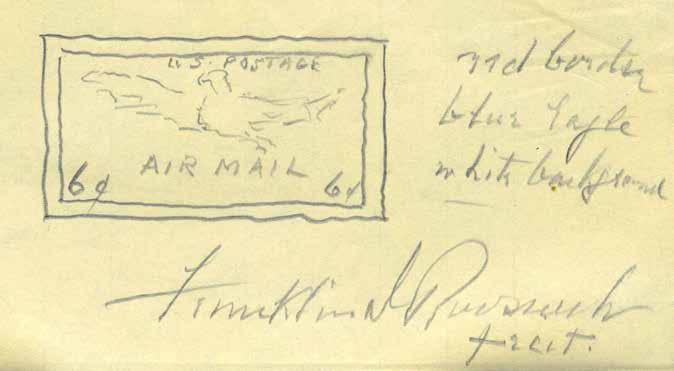
However, the actual development path was significantly more complex according to careful research by James H. Patterson using records from the Bureau of Engraving and Printing (BEP). His work indicates that all of the initial designs for this stamp proposed by the BEP featured mail planes for the vignette, not an eagle.1 Furthermore, all key development work on this design occurred during the last few days of March 1938 while FDR was away in Warm Springs, Georgia, with FDR not returning to Washington, DC, until Sunday, April 3, 1938.
Unfortunately very little in the way of artwork or photoessays remains, and the paper trail for this is primarily in the form of a flurry of correspondence in the BEP’s Production File. This begins with a Monday, March 28, 1938, letter from Alvin W. Hall, the Director of the Bureau of Printing and Engraving to Ramsey S. Black, the Third Assistant Postmaster General.1 The letter transmits “three models, different designs of the 6¢ Air Mail United States postage stamp (two colors) for consideration.” Furthermore, also enclosed in the letter were “two photographic prints” of airplanes “from which the models were prepared,”
116 THE UNITED STATES SPECIALIST
Figure 1. FDR’s undated sketch for the new bi-color air mail stamp (Smithsonian National Postal Museum).
although Patterson was unable to find any trace of either these models or the photographs in the BEP files during his research.1

Certainly the idea of using a mail plane on the new bi-color airmail stamp to be issued on the twentieth anniversary of US airmail service seems to be reasonable, but by the following morning the three models originally submitted had been returned, and the use of an eagle for the vignette was being considered instead. This is revealed in the March 29, 1938, BEP letter from Clark to Black, that states that “I am submitting an additional model of the 6¢ Air Mail postage stamp (two colors) showing an eagle as the central subject, for consideration.”1 This rejected photoessay apparently survives on a BEP “model card” similar to an example for the Win the War Stamp,2 and is shown in Figure 2.
Inspection suggests that this hurriedly prepared model is clearly a “paste up” employing the eagle depicted on the Great Seal of the United States that was previously used on airmail special delivery stamps of 1934–36.3 Was this in response to the President, who after learning of the initial models with mail plane vignettes, suggested an eagle instead? James Patterson seems to think so,1 and I would agree. Perhaps FDR thought that using a mail plane vignette on the new bi-color stamp would too closely mimic the design on the original 24¢ “Curtiss Jenny” airmail stamp, and that an eagle design would be more distinctive.
However, use of the eagle depicted on the Great Seal of the United States was also problematic, as it would seemingly lack originality and likely cause confusion with the bi-color airmail special delivery stamp. It is at this point in the chronology that Patterson suggests1 that FDR may have responded by sketching out a flying eagle with outstretched wings (Figure 1) and again I agree. Note that on his sketch FDR specifies a “red border” and “blue eagle,” the same colors used for the airmail special delivery stamp, potentially leading to confusion with it. But because FDR was away in Warm Springs, FDR’s sketch would likely not have been seen by the BEP.

In any event, there are two more
Tuesday, March 29, 1938, transmittal letters in the BEP file, one with “three additional models of the 6¢ Air Mail postage stamp (two colors) showing an eagle as the central subject, for consideration,” another nearly verbatim transmitting “four additional models.” From this, Patterson concludes that the BEP prepared a total of seven different
MARCH 2024 117
Figure 2. Rejected “eagle” photoessay for bi-color air mail stamp (BEP Production File).1
Figure 3. Final approved model of April 4, 1938 designed by William K. Schrage (BEP Production File).1
models for the new bi-color airmail stamp, three showing mail planes and four with eagles.1
FDR must have finally seen these BEP models, as a typewritten presidential memorandum dated March 30, 1938, from FDR in Warm Springs to Postmaster General Farley and Ramsey S. Black states:
“I like very much the air mail stamp which I have marked. I prefer the eagle to the mail plane. If the eagle on the one I have marked is made a sixteenth of an inch wider, it could not be confused with the 16¢ special delivery air mail stamp. Also, the colors being reversed, I cannot see any confusion.”1
On Friday April 1, 1938, Ramsey S. Black wrote to Alvin W. Hall at the BEP saying that of the seven models submitted for the new bi-colored airmail stamp, one “has been approved as to general design by the President.” He goes on to state:
“Please have a final model for the new stamp prepared accordingly to embody a blue border with red center, the latter to be in the form of an eagle with out-stretched wings. Please also note that, in the attached copy of the President’s letter of March 30, the central figure should be increased in width one-sixteenth of an inch.”1
It was on Monday, April 4, that the final model for the new bi-color airmail stamp shown in Figure 3 was prepared by William K. Schrage. This April 4, 1938, approved photoessay survives on a BEP “model card” and is signed on the back by Farley with the date April 6, 1938. For further information and details, the reader should review James Patterson’s excellent article.1
Although no examples of mail plane photoessays for this stamp apparently survive, comparison of the frames in the models shown in Figures 2 and 3 coupled with the knowledge that so little time was available for this development, suggests that the frame used for the mail plane photoessays must have been nearly identical. Since the mail plane vignettes likely included a “Curtiss Jenny” as used on the original 24¢ airmail stamp, this allows one to envision what at least one of the missing mail plane photoessays must have looked like.
Following the acceptance of the new design, the bi-color airmail stamp was announced by the post office on April 11, 1938, with it being scheduled for release on May 14, 1938. The frame and lettering for this stamp was engraved by W. B. Wells, and the eagle vignette by R. Ponickaut and Charles A. Brooks.4 For flat plate printing of these bi-color stamps, plates of 100 subjects were designed with two panes of 50 stamps. An approved plate proof of the vignette pane dated April 15, 1938, is shown in Figure 4, and a corresponding full plate proof of 100 for the frame dated April 20, 1938, is shown in Figure 5. Note that several features are incorporated into the printing plates to help ensure that stamps with inverted printing do not occur. This includes the word TOP designed to be printed next to each other in both colors, and a bi-colored cross to be printed at the top (left and right) of each pane. While several inverted sheets were in fact printed in error at the BEP, none escaped detection and were released to the public.5
Plate numbers on the printing plates only occur at the top, as seen in Figures 4 and 5, with one of the two identical plate numbers typically having a prefix letter F. Together with variations in marginal markings, many different pairings of plate numbers make the 6¢ bi-color airmail stamp quite complex philatelicly. In Figure 6, I show some examples of plate number blocks of four, the one on the left with the “arrow,” the one on the right
118 THE UNITED STATES SPECIALIST
I\PR

without. Numerous combinations of plate numbers are listed in the Durland catalogue,
into those with and without arrows.6 Following the first year of production, arrows no longer appear on the plates. There are also various printing alignment marks centered at the top, bottom and sides of each pane. These appear in various thicknesses, with some occurring as dotted lines, such as the red dotted line on the block at the right.5
The new stamp was issued on Saturday May 14, 1938, with first day service in three cities, Dayton Ohio, home of the Wright brothers, Saint Petersburg, Florida, site of the American Air Mail Society’s convention, and Washington DC. As a collector of
MARCH 2024 119
Figure 4. Approved plate proof of the vignette pane (Smithsonian National Postal Museum).
divided
T OP ""21840 I
15 1938
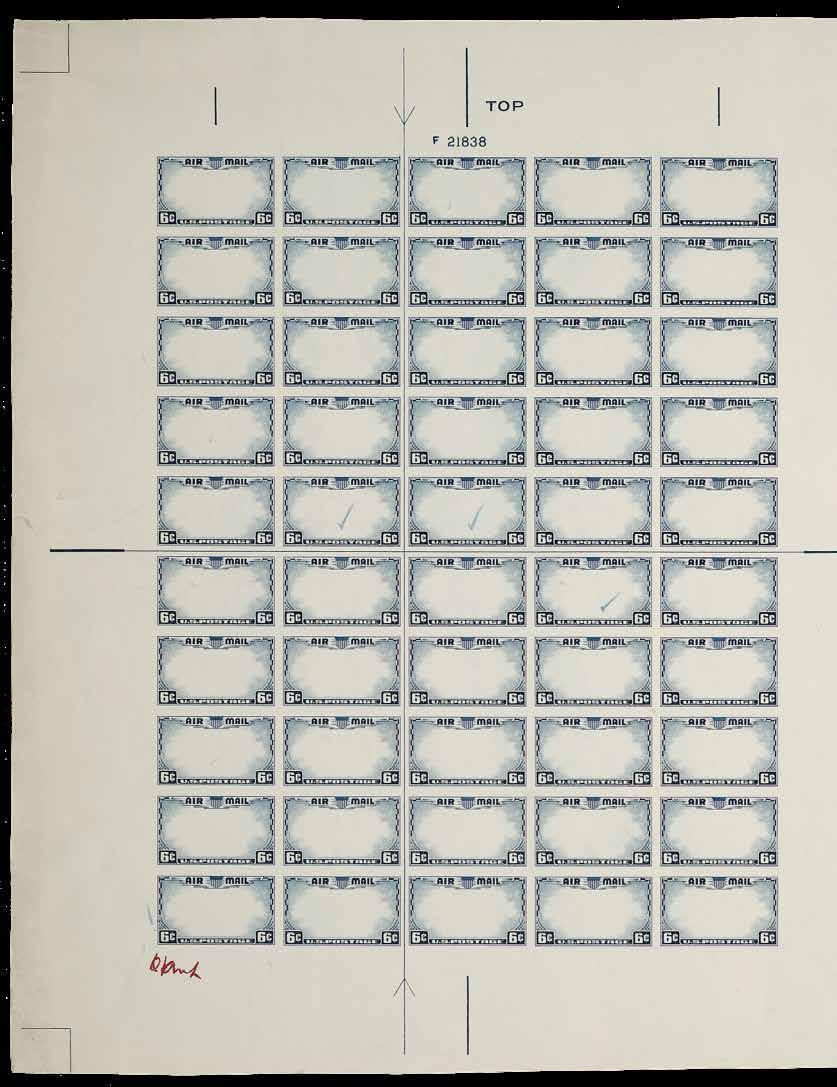
120 THE UNITED STATES SPECIALIST
_J I TOP I F 21838 7
Figure 5. Approved plate proof for the frame (Smithsonian National Postal Museum).

MARCH 2024 121 L TOP APR 2 0 1938 j-
TOP
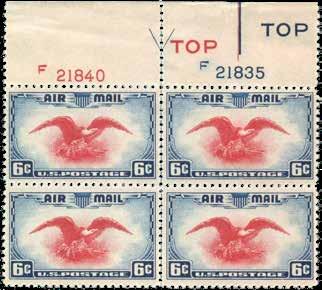

TOP TOP
Postmaster General (PMG) favor FDCs, I’m fortunate in having an official PMG Farley FDC from Dayton as shown in Figure 7. This cover was sent to a young Master Eddie White who came from a family of famous diplomats including William Pinkney (1764–1822) who served with James Monroe as co-minister to Great Britain in 1806–07, and Henry White (1850–1927) who was one of the signers of the Treaty of Versailles that ended World War I. Eddie began receiving PMG FDCs from Farley when he was eight years old.
Other Post Office officials also sent out favor FDCs, such as one in Figure 8 from the First Assistant Postmaster General W.W. Howes. Although without a letter, this is signed on the corner card. It was sent to Miss Ruth Carter, daughter of the famed Amon Carter when she was fourteen years old. Notably, as with those for her father Amon Carter, it is simply addressed to her in Fort Worth, Texas without a street address.
FDR was an avid stamp collector and besides the important role it played in his life, the hobby also provided a diversion for his White House staff, who were allowed to use White House stationery for FDCs. Perhaps my favorite among these are those sent to Jules Rodier, a white-haired telegraph
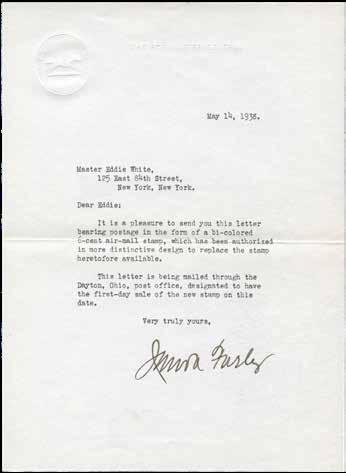

122 THE UNITED STATES SPECIALIST
Figure 6. Plate number blocks of four for the 6¢ bi-color air mail stamp.
! ±/TOP
.... ..~!~:1:9 ..... i F" IA fflll r.::;ar.,--..,"'"'._.r.ai.,;r;;,i;:all, ' ' • lha\u- lhtta-, 1t'j llln Ao, SVHt. IP f!Hk.. f.,, York.. lt It• 111,-111:lft t-> ,- t."l• \nt•r 6 -i:?M.LLI~ •lalll:>• ~lci..~'7,.,..-\J;.;,-iW laaon 1hUIK"1.l•• tJ,ni.,,,i \,f 11« \h<I :"Ah t•Uu- b '•1:.« UlliM U,.~ 1.1M ~11, C'll.lo, pott ••i,.._...t., 1.o be"• 1-11• nr.-~ -.1.• ot u.. '-'" •i.at ui '"'' uu
Figure 7. Favor FDC for the 6¢ bi-colored air mail stamp sent to Master Eddie White by PMG Farley.
operator who had begun working as a telegrapher at the White House during the Spanish American War when William McKinley was president. Two of Rodier’s first day covers for the 1938 airmail stamp are shown in Figure 9. Note that the stamp on the one canceled in Dayton shows clear traces of the blue line printed on each pane at the left and bottom, revealing that this is from plate position 23. The other was sent from the American Air Mail Society’s Convention in St. Petersburg, Florida.
To put the new stamp to good use, FDR and his Postmaster General James A. Farley came up with the plan for NAMW, which began the following day, on Sunday, May 15, and ran through Saturday, May 21, 1938. The goal of NAMW was to get every citizen to either mail or receive an airmail letter sometime during NAMW, thus helping the Post Office by increasing the use of airmail service and at the same time providing a boost to commercial aviation in the United States.
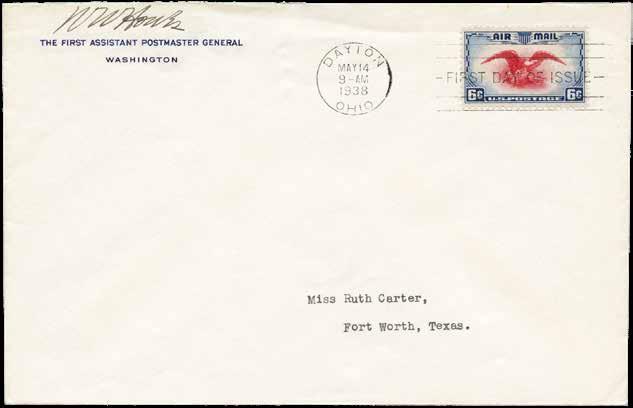
Among the distinctive NAMW cachets used are beautifully printed examples that also include printed information on the back of the cover. An example of one of these mailed on the first day of NAMW from Denver, Colorado is shown in Figure 10. This was sent to James M. Mead, Chairman of the Committee on Post Offices and Post Roads, House of Representatives. Mead, who later became United States Senator from New York, was also a stamp collector who was said to have “the largest collection of anyone of Capitol Hill.”7
Featured is a multi-color printed cachet that touts Denver as America’s Vacationland. On the back is a printed invitation for a special ceremony July 3 at the top of Berthoud Pass to celebrate the completion of the paving of US Highway 40, the “highest, shortest and coolest of transcontinental routes” that also states that “You’re invited to come --- and throw snowballs.” This was an important feature for vacation travelers before the advent of air-conditioning in automobiles, and a good reason for them to pick a route through Denver. A bonus discovery inside this cover was the original letter to Mead shown in Figure 11. This is on official NAMW stationary from Colorado’s “State Headquarters Air
MARCH 2024 123
Figure 8. Favor FDC for the 6¢ bi-colored air mail stamp sent to Miss Ruth Carter by First Assistant PMG W.W. Howes.
M1 s s Rut h Ce.rter, Port worth, Tens.
Mail Week.” Note the printed footer urging “One Air Mail Letter a Day from Every Colorado Citizen,” a laudably ambitious goal!

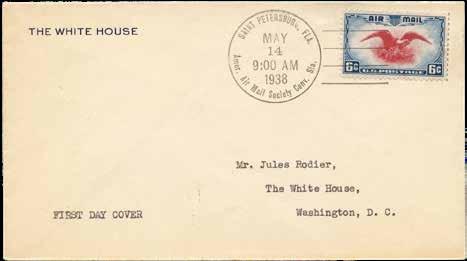
Another example of a colorfully printed NAMW cover mailed on Sunday, May 15, is one sent to FDR from Milledgeville, Georgia, in Figure 12. Milledgeville was the capital of Georgia from 1804 to 1868, including during the American Civil War. The cachet shows the state capitol building in Milledgeville, the city’s seal and flags, along with portraits of John Milledge and Abraham Baldwin, Revolutionary War figures and early Georgia politicians. Printed on the back are the words of the “Song of Milledgeville.” There is also an H. R. Harmer auction backstamp showing that this cover was sold in the December 1946 sale of FDR’s stamp collection.

C oMPUTION of hard-surfacing, coast to coast, of U S 40 Highway, will be celebrated on top of Berthoud Pass, near Denver, July 3. States along this highest, shortest and coolest of transcontinental routes, will participate You're invited to come • -- and throw snowballs.
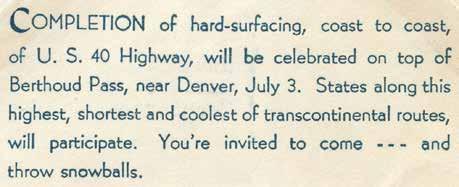
124 THE UNITED STATES SPECIALIST
Figure 9. FDCs on official White House stationery.
T HE:
E
nF.ST NY oovm 11 blngto• , D O TH E WH I TE HOUSE Tha 1'bi h Bou N , nBrll'D.I"COVZll
Figure 10. NAMW from Denver, Colorado sent to Congressman James M. Mead.
WHITE HOUS
Mr. J'u.lae Ro41ar,
VIA A IRMAIL
Ho ~ora le Ja~ez '. Uea M , Ho use or nepr~s~~~ ati v e s, ~ashineton , D c
.
b...._ d..,cw
"° !Jlpr:,.,.. w Po.11. otnee Fr!L.Lt.rmll,:, , I n ..,
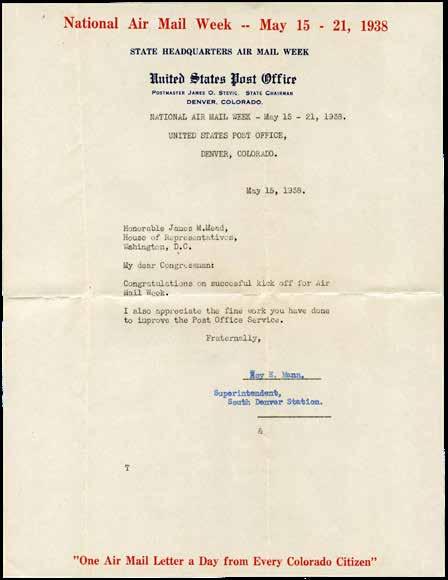
"One Air l.1a.il Utt.er a 0a, from E\ en Colorado CitizHJ
Finally I show another example from my collection of a May 15, 1938, printed NAMW cover from Berkeley, California addressed to Postmaster General James A. Farley. Shown in Figure 13, the cover is signed by the local postmaster. The cachet shows Sather Tower (also known as the Campanile) the third highest clock and bell tower in the world, and an important symbol of the University of California, Berkeley. Also shown is a portion of the San Francisco-Oakland Bay Bridge, completed in 1936, six months before the Golden Gate Bridge. On the back is a printed blurb touting the amenities of the Berkeley-Albany residential area.
Ultimately, thousands of towns and cities across the United States participated in National Air Mail Week, giving

"({5h~ Song of &lfilledget~llf'
f.aor M1lh,i:lg'1'vlll• , tJ.illtdg-HHI•, lov•ly lown. Wllh ~l'ldt,cispe .au-P9rb <&Pd :nlludon •ublim.0. IJn.d lot 1.lm• ._nd fo, o,.....,t r.,nown
VIA AIR MAI L
Th e Pr e s ident or the United States
The •lhi t e !louse
Ja ah1J1&1,on, D, o MA Y 15 21 •938

r~l M1llr~" vlU• !.hUedg11,.111 • not.la $0\rilft, Con(.,,,,,.., ond d iQl"l•d IC d"'elo,, our Ullii!>, Eur amt.kt/out kit °"'91-'.1 ,~nown. rroo Lh• doy ol ,-our birth to tho 11nd or tlto,ol ro11tbtl.l.1 ffld no wh.al ltil• mn11 yw o D04!11 ktr w• tm,.- w• a~ r1ght - We flt,g you a lout.--o loOlt n•r Yi,u our GeoigJa·& beat Cdp!Lol •Hal Vou """""• G..:irvte •till krr JCIUt h,.af, b 111.1• blue
Words by E. A. TI,pe-r laQllf. :,tMJt. FIANIClJN Ii. fUJfhlJ-:VELT r,o~ uumc by Or ,o,d "'11'9- Mu [JQ4t, A tf'CTIONE;D DBCF-'4:B&H ·~-a. IIU a T H. Jl HAJt~ ~:w rsc- ;-,: v
to FDR from Milledgeville, Georgia.
MARCH 2024 125
Figure 12. NAMW cover sent
National Air )tail Week •· May 15 21, 1938 8TAT8 ll 6AOQUAR TEkS Al I JI.UL Wt.EK l11lltb &talts Jost <Offlcr .,_n.._.,., J•-.u O lht'l'MI •u" c.u OUIVUI COLOWA DO 1.,,now...r,. All llilL, .1:IZ - lili.1 l$ - 21, ll::.3 , t.!lin'Etl ST;:.m POt.'f omcr; , IIDl'VDl,l!•OUC"n'ba Ja...~~ 11 11..4111 llcK.tct ,,f k..pn:~n-t-.th.11 , 14biA4t-; R, t:, C, .,. -war C.o~•.libl.tH t &l.llo :.W-<ocllt..J u.., t'1Dti, oe.,rlt r,u
Figure 11. Letter from Colorado state NAMW headquarters sent to Congressman James M. Mead (author’s collection).

VIA AIR MAI L
l!onorsble Jesn~s A. J'eley, Postmaster General, 1'aeh1ngton, D, C. ...
Berkeley • Al bony • Tho supe rb re,idontiol district of the SM Frondsco S.y A,e,,, nestling ot the foot of hills and upon the shore of the Boy mode famous by Dons Md '49en; - site ot the lovely grounds of the University of Col iFotnio - equitable climate, cultural ,urroundings, and p,oximity to e metJopofis combine, to fflllke th11t!.ll!t communities the perfect home s.ite for the ric:h enjoyment of fomily or retired fjf.,,
I:. I. McCORMAC, Historion LLOYD C. M. HAR£, Author
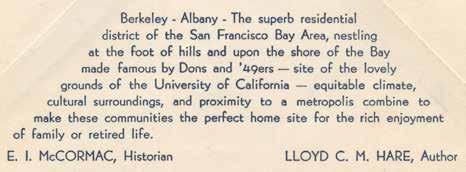
each locality a chance to boast about what made them proud, special and important. The numerous locally developed cachets they produced resulted in an outpouring of authentic Americana, providing both a boost to civic morale and providing collectors with fascinating mementos. The successful implementation of National Air Mail Week represents yet another highlight among the many contributions made by FDR and James A. Farley to the “Golden Age of Stamp Collecting” and in Part II, I plan to show a wide range of NAMW covers including many sent to FDR .
Acknowledgment
The author would like to thank Scott Tiffney and the American Philatelic Research Library for their help.
References
1. James H. Patterson, “The Design of the 1938 Eagle Airmail Stamp,” American Philatelic Congress Book (1996), pages 1–27.
2. Paul M. Holland, “FDR and the 3¢ Win the War Stamp,” The United States Specialist, March 2023, pages 105–106.
3. Paul M. Holland, “FDR’s 1934–36 Air Mail Special Delivery Stamps,” The American Philatelist, September 2019, pages 822–827.
4. Brian C. Bauer, Franklin D. Roosevelt and the Stamps of the United States 1933–45, Linn’s Stamp News: Sydney, Ohio 1993, page 166.
5. M. O. Warns, “The 6c Bi-Color Air Mail Stamp of 1938,” The Airpost Journal, May 1947, pages 300–305.
6. 2000 Durland Standard Plate Number Catalog, ed. by Kim Johnson, United States Stamp Society: Reston, VA, pages A6-A8.
7. Alvin F. Harlow, Paper Chase: The Amenities of Stamp Collecting, Henry Holt and Company: New York, 1940, page 136.

Quality US Stamps
At Competitive Prices
Fre e pricelist avail a ble vi a m a il or on my web site. Mint & used sin g les , blocks , pl a te blocks , & back of book. Ne w issue se rv ic e ava il able.
Scott A. Shaulis
P.O.Box 549
Murrysville , PA 15668
scott @ shaulisstamps.com
www .shaulisstamps.com
126 THE UNITED STATES SPECIALIST
Figure 13. NAMW cover from Berkeley, California addressed to PMG James A. Farley.
--

From the Washington-Franklin Committee
Chasing the Dr. David M. Bennett Collection of 1918–20 Offset Issues
by Larry S. Weiss USSS #8558 | m a1antiques@att.net
This is the story of my hunt for the elusive Dr. David M. Bennett offset issues collection.
Dr. David Mayer Bennett, USSS 1171, was a legendary collector of the 1918–20 offset Washington-Franklin head issues (Scott 525–536, K18), studying these stamps since the 1930s and publishing more than 55 articles on the subject.
He was by profession a dentist, practicing first in the Bronx and later in White Plains, New York. In 1961, he “Americanized” his family’s surname from Berest to Bennett. Biographies of him appeared in the Specialist in 19701 and 1974.2 A photo from the earlier article is shown here as Figure 1.
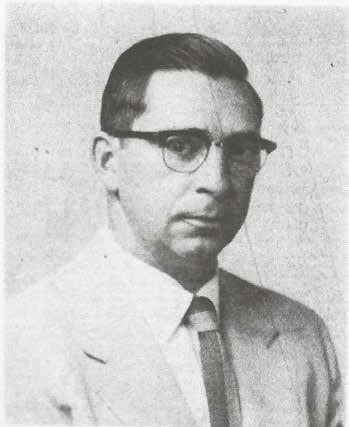
He started his dental practice during the Great Depression in the mid-1930s, with his “office” in his parents’ living room and his mother serving as receptionist while cooking for the family. Some early dental clients paid for his dental services in kind, instead of money. One couple needed a lot of dental work, paying him with old US Revenue and Match and Medicine stamps. His intellectual curiosity in those stamps triggered his collecting. His own limited funds led him to study the offset issues since a great many examples could be obtained at modest cost.
He proudly served during World War II in the US Army Dental Corps, but when he was discharged in 1945, he had to restart his dental practice from scratch. He told me that, particularly in the early days of his dental practice, there were long dead periods
MARCH 2024 127
Figure 1. Dr. David M. Bennett, 1958, as shown in the Specialist, 1970.
between patients and so he had much time to study his beloved offsets. Eloise Hintersteiner, his daughter, recalls:
During my childhood, his great joy was to take a Friday off, for a subway ride down to the stamp dealers located on Nassau Street in lower New York City. There he whiled away the hours looking through their wares, and came home with his pockets stuffed with large lots of inexpensive stamps. Most were offsets, but he also enjoyed precancels. In those days, transactions were conducted in cash, and he was eager to prevent my mother from knowing what he was spending!
I remember him sitting with his Bakelite magnifying glass (I still have it!—see Figure 2) fly-specking dozens of stamps at a time, with an occasional exclamation of “Look at this one!”. Then he would show me a stamp that had acquired a little extra blob of ink, a blurry double-impression, or some other printing mishap! He was also interested in offset stamps used on cover during WWI, especially to or from exotic destinations (see Figure 3). It was indeed an intellectual challenge.
V
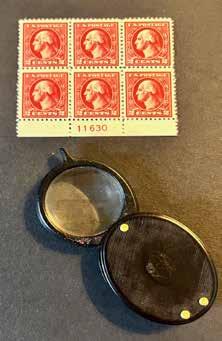
Dr. Bennett in his examination of the offsets. It is only 4X power, a surprising choice as current collectors often use 10X to 30X for examination of fine detail. The plate block is a Type VI offset, 528A.

the
as domestic mail, properly paying the 1 to 2 ounce
ounce rate. Sent by an American Red Cross (ARC) stenographer stationed in Warsaw, Poland, to her sister in the US. The cover was censored by the ARC rather than military censors, as was the normal practice at the time. The cover went by routine military mail to Paris where it received a “US Army MPES 702” on May 27, 1919. In the US it received cancels from Maplewood, N.J., the nearest post office to the destination. Covers “used abroad” with offset issues were of particular interest to Dr. Bennett, his collection also having examples from France, Germany, China, Haiti, Siberia, Canal Zone, Puerto Rico, Guam, US Virgin Islands, Samoa, and Alaska and Hawaii (then still both US territories).
128 THE UNITED STATES SPECIALIST
Figure 2. The Bakelite magnifying glass used by
Figure 3. An ex-Dr. Bennett cover from Poland to
US using two 3¢ offset stamps, Scott 530. It was treated
war time 3¢ per
----• ---------------=----
--·
\.l. C,S _ .,...sr-aa,,,.~d
'J.
Jere
COURT
 DO NALD F LYBARGER
DO NALD F LYBARGER
..JUOGE:
COURT OF COMMON
CUYA~OGA CO U Nj'Y
PLEAS
July 15th, 1958.
Mr. David M Berest, 3436 Corsa Avenue, Bronx 69, New York.
De ar Dr Berest:
I am glad to know of your interest in the offset issue of 1918 - 20. That was a consuming interest of mine for quite a few years. Unfortunately I disposed of my collection about ten years ago and since that time have done very little with the offsets At the same time if I can ever be of any help to you I shall be glad to hear from you further.
You ask concerning the "retouch on cheek " variety of the two cent tYPe 7. I think it is one of the most spectacular minor varieties of this issue.
I wish I could have before me a copy of this variety which I formerly owned. I do not now recall what size block it was in. As a matter of fact I don't recall whether I meant the eighth row vertically or horizontally. I am quite sure, however, that there was only one such variety, and that your block indicates the exact position of the stamp in the sheet, namely in the ninth horizontal row of an upper pane.
I happen to have on hand a plate number block with one of the hand l e ttered numbers on it. I shall enclose it for your inspection. If you are interested in it you may have it for ~matever you apprai~ if at.) If not, I enclose an envelope for its return. l' ')_ ~b,· t \
Please do not hesitate to call on me if I may be of further service.
Ve ry truly yours, DFL/wh.
MARCH 2024 129
Figure 4. A letter from Judge Donald F. Lybarger dated July 15, 1958. The letter mentions the disposal of his offset collection some 10 years earlier. It also comments on the sheet position of a “retouched cheek” constant variety appearing on Type VII offsets such as Scott 528B. That variety is shown in the next figure.
HOW$E

Previously, study of the offset issues by Donald F. Lybarger (see Figure 4) resulted in the first comprehensive work on the subject. It appeared periodically in The American Philatelist in 1937, culminating in its compilation into a booklet3 available for $1. Dr. Bennett noted this inspiring work in his 1946 Specialist article titled “Why I Collect the Offset Issue.”4 Dr. Bennett’s studies and that of Lybarger later formed the basis of many Scott Specialized Catalog listings of the offsets. An example of a Scott-listed constant variety on an offset printing is shown in Figure 5.
Dr. Bennett’s interest and leadership in offset stamp studies led to his formation of one of the premier collections of the offsets. In 1946 he began his long-time role as Chairman of the BIA/USSS Committee on Surface Prints. Besides his chairmanship, he served on the BIA Board of Governors as Vice President, then President, 1974–77 and as Chairman of the Board, 1977–1980. Despite his leadership in the study of the offset issues, he always considered himself a student of the issue, not its master. He took on the challenge of identifying and reporting not only the significant varieties, but the more daunting task of cataloging the many constant minor varieties. Dr. Bennett published his studies in a multi-part series of articles in the Specialist in the early 1970s under the title “Constant Minor Varieties on the Offset Printing Issue of 1918-20".5 Later Loran C. “Cloudy” French’s Encyclopedia of Plate Varieties on US Bureau‑Printed Postage Stamps6 encompassed Bennett’s work and several other sources.
Kelley.)
My own interest in the Washington-Franklin Heads (Scott 331–547, K1–K18) developed during the mid-1970s, starting with my acquisition and thorough reading of all available literature. The offsets, a small but significant subset of the Washington-Franklin Heads, were of course among my interests that led to contacting and visiting some of the then-current collectors. Dr. Bennett’s frequent contributions to the Specialist made me aware that he had built one of the best collections of offset issues and I desired to learn from viewing it and interacting with this now legendary offset collector.
In 1972, I had moved from Idaho to Niantic, Connecticut, leaving me near my New York City birthplace and within a two-hour drive of Dr. Bennett’s home in White Plains, New York. My wife and I took many trips to New York City to visit relatives. During one such trip, I arranged to stop and have a short visit with Dr. Bennett and his wife, Rose. We had never met before and I sensed he was apprehensive of immediately showing me any part of his collection, as we talked for quite a while before he brought out just one stamp for my viewing. It was an ordinary used three cent offset, Scott 530—nothing special and not in particularly good condition, like the example in Figure 6. He asked
130 THE UNITED STATES SPECIALIST
Figure 5. A constant variety—Scott 528 B showing a retouched cheek. Dr. Bennett verified the consistency of each variety he reported by acquiring at least two and often three or more examples of each variety. He had a large number of single examples with varieties awaiting the finding of a second example. These went unreported. (Courtesy Andrew
me to tell him all about the stamp—an obvious test to see if I was truly a student of the offset issues or someone with other intentions.

I recall rattling on for at least five minutes, describing the reason the stamp was issued, how it was printed in comparison to previous issues, why that method was used, its design features and differences from the similar three cent Scott 529 and previous engraved issues, its perforation, the paper and its lack of a watermark, its postal uses, its major varieties, a minor variety on his example, the postmark and a description of the defects I could see without watermarking. I started on its dates of issue and postal history, thinking I would finish with the pertinent philatelic literature, but by this point he apparently had enough and we were now on speaking terms as fellow specialists. We talked further about projects we had in mind for studying the offset stamps. Due to time constraints, I soon had to leave and complete my trip to New York City. He promised in the future to allow some viewing of his collection. So, this first meeting ended with just a look at one used, common offset-printed stamp, which was not even a sound example.
Over the next few years we corresponded but met only once more, during which time I had the chance to see some of his remarkable offset collection. Parts were mounted for exhibit, but most were simply in stockbooks. I hardly had a chance to study his material before circumstances moved me to Pittsburgh and our only interaction became infrequent correspondence.

In the 1980s, Dr. Bennett’s health declined and his dental practice became a limited semi-retirement activity. While he had plenty of time to continue his philatelic pursuits, he began to realize he would soon have to deal with the dispersal of his collection.
Our correspondence became infrequent. In 1984, I began the Washington-Franklin Committee and started writing articles, with Dr. Bennett’s material often providing subject matter for presentation. He was still very willing to share his knowledge and allowed use of his holdings. An early participant in the Committee, Jerry Nylander, had interests similar to my own, including the offsets, and we collaborated on some investigations. Contact with Dr. Bennett was eventually lost in the first of what was to be many such events regarding his collection.
MARCH 2024 131
Figure 7. Eloise Hintersteiner, daughter of Dr. David Bennett, 2014.
Figure 6. A 3¢ 1918 offset issue, Scott 530—a poor example like that presented by Dr. Bennett during the author’s initial meeting with him.
I wondered what had happened to Dr. Bennett’s collection. What I did not know at the time, but now have been advised, is that his daughter, Eloise Hintersteiner (Figure 7) had taken an interest in the collection. She may be remembered by some of our older members as having served as BIA Executive Secretary from September 1978 to March 1979 and remains a member to this day (USSS 9440). We corresponded briefly, but contact was lost once again. Meanwhile, Dr. Bennett’s declining health led him to begin disposal of his collection.
Dr. Bennett consigned the majority of his collection to the Robert A. Siegel auction firm in New York City. The sale with his offsets was held October 23–26, 1984,7 as part of one of the firm’s regular sales. Siegel did the lotting. Most of the collection was auctioned off by Siegel in large bulk lots, many of which contained rarities and specialized items within them, along with other items of little philatelic value or interest to serious collectors. Some specialized items that had been featured in philatelic literature were also embedded within the bulk lots.
From my viewpoint, the Siegel sale was a once-in-a-lifetime opportunity to acquire key parts of his collection. Jerry Nylander and I realized our common interest in acquiring much of what was offered, yet neither of us had the resources to acquire it all, so we decided to bid on different lots so that we had the greatest chance of acquiring all the lots most important to us. At the time of the auction I was living in northern New Jersey and working in New York City, but on assignment at a nuclear power plant being built in Braidwood, Illinois, about 70 miles south of Chicago. Jerry, living close-by in the Chicago area, came to my hotel room in Shorewood, Illinois, to plan our bids. We spent many hours developing bids and trying to determine which lots would have the truly difficult-to-find material. We skipped high value items such as rare plate blocks and anything we thought would likely come up in the future. I remember stretching my limits to the point of possible domestic strife should we be very successful.

The plan was for me to personally attend the auction and execute the bids, controlling how much we spent overall and trying to get the most important lots. I headed back to New York City to spend a day viewing the lots, adjusting our bids accordingly, and spending another day attending the auction. We were hopeful and excited as to what treasures we might obtain in the sale.
To say the least, things did not go as planned. On nearly every lot of interest we were outbid by an unfamiliar gentleman sitting in the front row of the auction room. I even upped many of the bids from the planned limits, but that still resulted in being outbid by that front-row sitting bidder. Out of more than 50 lots we planned to buy, I acquired just a few and spent only a small fraction of what we had allotted. How disappointing!
132 THE UNITED STATES SPECIALIST
Figure 8. The headstone of Dr. Bennett and his wife Rose. Note the “album” theme so appropriate for a philatelist. The album motif actually signifies their entry in the Book of Life (an honor reserved for those considered righteous)—fitting given the way the Bennetts conducted their lives.
Identification of Types of the 2c and 3c Offset Issue Stamps
Duri ng the past several years there have been received many roquests from coll ectors for a simple means of distinguishing the vario u s types of the 2c and Jc offset issue stamps, Nos. 526 and 529. It is also my experience tha t many dea le rs h ave difficulty wit h this issue.
Th ere are, cf course, several publications, including Max Johl's "The United Sta t es Stamps of the Twentieth Century" and Donald Lyba rge r 's "The United States Issues of 19 18-20", which h ave elaborate descriptions a n d illustrations of these types. The Scott Cata logues, general and specialized, go into less de tail in their drawings and t ext. The average co ll ector, h owever, finds there is t oo much "fine p r int" and has the t endency to pass by this information as beinQ "too complicated". It is with the purpose of making t hi s information more acceptable a nd providing me mbers with a permanent record that the following chart has been worked out. Also it ls hoped that more of the membership will find the offset issue of increased inter• est, which in turn will occasion further study.
Acting on the theory that "one picture is worth a thousand words", special attention has been given to the accompanying drawings, prepo>red by Mrs. Carolyn P. Kuhn, Chairman of the 2c Washington 1922 Comm ittee. Mrs Kuhn's exce llent articl es and illu stra tions have been appearing in the "B ureau Specialist" for the past two years and we are indeed fortunate in ha ving obtained he r .services for the offset type ill ustra ti ons.
In both the text and il lustration"\ every at• tempt has been made to e liminate excessive deta il and to point up th e really sa lient features of each type. A little pat ience a nd application s hou ld ~nab 1e any collector to become adept in identifying the v.irious types
Let us assume you have a 2c No. 526, and wish to determine its type. Use a lens (two or three power is sufficient), and hl!-gin by examining the button on the toga. If the sh3ding lines in the b utton form " 0 1D" (See Co l 1) you r stamp is Type IV. If not, the n proceed.
Now examine the line of co lo r separa ti ng the upper and lowe r halves of the left "2" (See Col. 2). If this li ne is decidedly heav-
ier than the corresponding line in t he right "2", you r stamp is Type VI.
If the separating li nes in both t he left and right "2s" seem equal in length and intensity, you probably ha ve a Type VIL Double check this by examining the number o f rows of vertical dots on the upper lip (See Col. 3), If you r sta mp s hows three vertical rows of dots it is definitely a T ype VII.
If the separating line in t he left "2" is thin, incomplete, or broken (as compared with the ri g h t "2") then you have eithe r a T ype V or Va. To check, examine the shading dots on the n ose (See Col. 4). If a ll the dots are present, yo ur sta mp is Type V. If there is a space abo ut h a lf way up the right s ide o f the nose, due to t he absence of two of the shad ing dots, your stamp is definitely Ty pe Va.
The identification of the Types of the Jc stamp is quite s imple.
Begi n by exa mining the "PO" of "POSTAGE". If the letters arc separated by a line of colo r (See Col. 1) your stamp is Type Ill. If the letters are joined, it is Type IV.
To check you r result, examine the toga butt on (See Col. 2). If you find that the center shad ing line consists of two dashes with a central dot between the m, then you ha ve a Type Ill. If you find that the center shading li ne is complete and has a dot in its cente r a nd that the shading line on either side consists of two dashes, then you have Type JV.
You ca n check further by examining the frame line at t he bottom of the vig nette (See Co l. 3). If this frame line is comp lete, you have :i Type Ill ; if this line is broken , you h:ive a Type IV.
Anot h er means of differentiating between the two types of the Jc s tamp (tho u g h not a thoroughly reliable one) is by its shade Th e Type Ill is violet (more blue}, and t he Type IV is purple {mo re red).
It is hoped that t he classifications above will be useful in as.sisting those who have had diffic ulty with the T ypes of the offset-issue stamps. Your chairman will welcome a ny quest ions or requests for assistance, from any membe r
The offsets have been my spe cialty for almost $ 0 years! Approvals, on request, are available f o r mi nt, used, plate blocks, precancels, pe rfins, c ons tant varieties, EFOs, etc, Also available, a re hundre ds of covers, including slogans, RPOs, ,iachine cancels, W",-l I, used ab r oad, etc.References, please.
David Bennett 11 Sammis Lane White Plain s, N.Y. 1060$

Figure 9. Dr. Bennett photocopied a page from his article in the Specialist for September 1951 (pp. 168–171 and reprinted September 1987, pp. 406–407), added examples of the types at top and a 1¢ offset, plus the typewritten note at bottom. Each of the stamps has its Scott number and type penciled behind it. He offered to send on approval specific items from his collection. The sheet shows folds to fit it into a #10 envelope. Records do not exist showing the recipients of the offer and what was sold in this manner. He had collections of offsets with precancels and perfins that may have been sold by this offering, as they were not in the 1984 Siegel auction sale and were not found by his daughter.
MARCH 2024 133
$28 -va
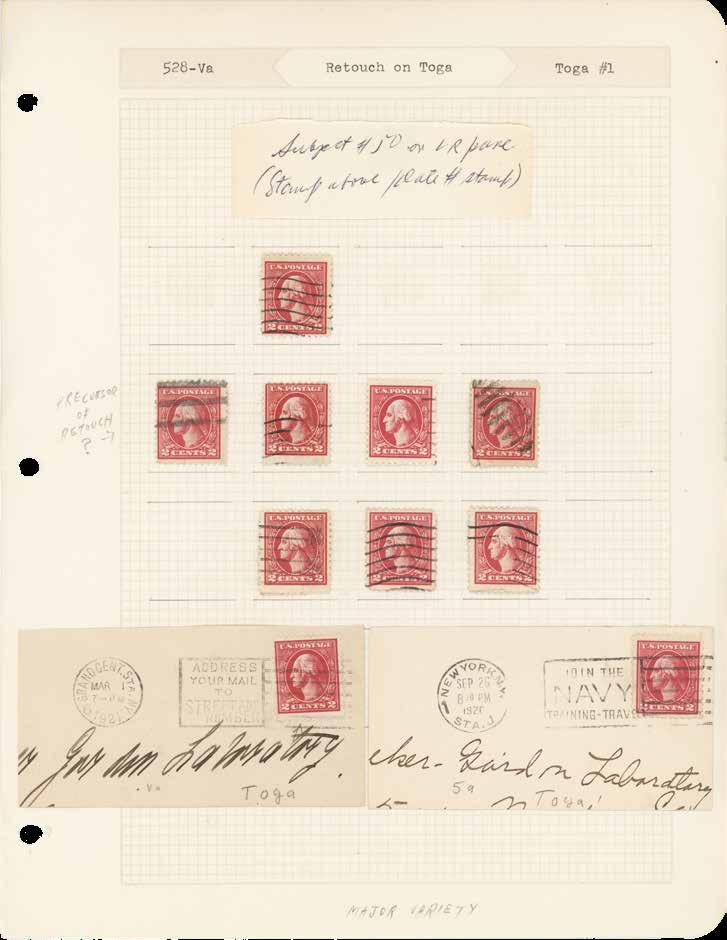
Retouch on Toga ~,,ycf~/t'<'l• 1£/••N:
French talks about it being on plate 11380,
is just one of many plates with the retouch. He cites two sources, including a June 1972 article by Dr. Bennett that article identifies it as from position #50 on the LR pane (i.e., just above the plate number). Interestingly, there seem to be two different versions of this retouch, with one being much less common than the other. The penciled note at left by Dr. Bennett suggests the stamp to its right shows a “precursor” to the more dramatic retouch; more likely it is a second, less common variety.
134 THE UNITED STATES SPECIALIST
Figure 10. A recently-found page from Dr. Bennett’s collection showing examples of Scott 528, the 2¢ Type V offset issue, with a retouched toga variety which is Scott-listed but not priced. The script note at top identifies the plate position of the variety as “Subject #50 on LR pane (Stamp above plate # stamp).”
but that
• • •
//t;u,,,./ "t,--1, t_ 17t',,.,i) # ~~,,./)
Toga /Jl
But who was it that had outbid us? I thought I knew all the major collectors of Washington-Franklin Heads. At the end of the auction, I approached the high-bidding stranger and met the friendly person who turned out to be a dentist (a remarkable coincidence!) from the Baltimore, Maryland, area. I asked about his interest in the offsets and surprisingly found his collecting had started with the first lot he purchased in this auction! I explained my interests and how I would appreciate access to the collection to further study its contents. He readily agreed and we exchanged contact info—addresses and telephone numbers.
A week or so later I sent a letter to him and, to my great surprise and chagrin, it came back later marked “Deceased” and unopened. I called the telephone number, but it was never answered despite my leaving a few impassioned messages on its answering machine. Repeatedly, I tried the mail to no avail. I eventually gave up and was again left wondering what had happened to the Bennett material. I thought that was the end of the story, but there was more to follow.
Dr. David Bennett passed away in 1988 (see Figure 8).8 At the time, USSS Chairman of the Board John Meek wrote that Dr. Bennett’s files went to me, however, I do not recall receiving anything and have no current assemblage of his files or notes. If I had anything, they are now in my files that I turned over to the then-current Washington-Franklin Committee chairman Jerry Nylander. Having recently passed away,9 his files have become unavailable to me and thus there is another “lost” part of the Dr. Bennett collection.
A few years later in the late 1980s when I was living in northern New Jersey, I taught an APS Summer Seminar course on the Washington-Franklins to about 20 students. At dinner one night, I told the story of how the Dr. Bennett offset collection had slipped into oblivion. One of the participants piped up suddenly and said that the dentist, who had purchased so many lots in the Siegel sale, had been one of his neighbors and had passed away. Fortunately, he still knew the family well.
He explained the dentist found he had a severe illness and he then willfully stopped caring for himself, taking no medicine and eating all the wrong foods. In addition, he inexplicably went on a stamp and coin buying frenzy, doing what he did at the Siegel auction at several other stamp and coin auctions. He lasted only a few weeks after the Siegel auction, before his suicidal actions caught up with him. Most of the packages of stamps and coins arrived at his home after his hospitalization and death. His wife and two young boys were totally distraught over the situation, but the auction bills dutifully got paid. They were not immediately ready to deal with the stamps and coins and they put the packages in a living room bookcase, intact as received with only the payment envelopes missing.
There they remained for many years, an unwanted bookshelf memorial to sad events. My Summer Seminar student was kind enough to put me in touch with the family. Circumstances had changed for them over time. Life insurance money was running out, the two kids were now ready for college and the wife was emotionally ready to deal with the stamps and coins. The timing of my call to come help as an APS Estate Advisor, one of my many hats, was welcomed. I, of course, wanted to see the offset material. I traveled with my family to Maryland one Saturday and spent the day with the dentist’s family sorting out the many packages of stamps and coins. Based on the invoices retained with the stamps and coins, there was plenty of money involved.
MARCH 2024 135
For the Siegel auction, I showed them the notations in my copy of the catalog proving the bids I made were the underbids on the lots. They were kind enough to let me buy a thousand dollars worth of the lots I had missed. That hardly made a dent in the holdings, but it was all I could manage without divorce (or murder, which my wife noted was quicker and surer).
I suggested to the family that the remainder of the offset collection was best consigned to the Jacques C. Schiff, Jr., auction as he had a good following for US and Error, Freak and Oddity material and would break down the lots much more than did Siegel. They did consign the offset material to him and other material to additional auctioneers. The offset material mostly was sold in 1986 Schiff auction sales starting at the beginning of the year10 and it was spread over more than just one auction. Prices realized were strong and again I missed most lots of interest. So, finally the Dr. Bennett offset material that had been in the 1984 Siegel auction reentered the philatelic market.
That does not end the story of the collection! Eloise Hintersteiner tells the remainder of the Dr. Bennett collection story:
As the name David Bennett was well known in the philatelic literature, to thwart a potential robbery, he squirreled away his Offset Stamps around the house. In 1984, when the majority of his rarer Offset items were auctioned off by Siegel, he apparently missed finding some tucked away stamps in out-of-the-way places (what I call the “remnants”).
Those remnants formed for Eloise a small starter collection of the offsets. Eloise acquired additional offset issue items from various auction houses and dealers. She writes:
Around 30 years ago, I decided to add to these remnants by purchasing Offset Stamps via auction and from dealers. There were many smaller and diverse auction houses then as compared to now. Unfortunately, I often bid close to or over Scott Catalog value. The Westchester County Center, located in White Plains, NY where I lived, had a Stamp Bourse that I went to about twice a year. I became especially interested in the EFO varieties of offset stamps, and I bought offset items such as misfolds and misperfs. I also became interested in WWI covers from Siberia, and covers with unusual postmarks, irrespective of the stamps on them. As with many collectors, I enjoyed “the hunt” for new material, both Offsets and non-Offsets, but I made the common mistake of overpaying for material of only average quality. I eventually realized that quality was more important than quantity.
Also about 30 years ago, I decided to concentrate on the Match and Medicine stamps, starting with the collection my father had accepted as payment for dental services many years earlier. I sold all of my Match and Medicine stamps, and my Revenue stamps, in the November 2021 Michael E. Aldrich Auction, where my collection was featured as “The Eloise Collection".
Eloise decided to dispose of most of her offset issue holdings about 20 years ago. She first attempted to sell at the local stamp bourse, but the dealers were either not interested in the offsets at all or they offered a pittance.
136 THE UNITED STATES SPECIALIST
Eloise’s own offset issue stamps, and her father’s remaining material, were sold by auction in the Siegel Sale 962 in September 2008.11 Siegel did the lotting. Of particular note was lot 2824. Most of the material in this lot originally belonged to Dr. Bennett and it reflects his intense decades-long study of all the varied aspects of the offset issues:
1918–20 Offset Issue, Printing Varieties. Approximately 200 stamps in singles, blocks of four and plate no. blocks of six and larger (Nos. 525–528, 528B–530, 534), incl. No. 525 “flat nose", 525c block of four with B. K. Miller thumb prints on reverse (Miller is generally accepted as the discoverer of this error), three used with no. 526 “gash on forehead", 527 line through “2 EN ” and 528 “CRNTS", these varieties are listed and priced unused only, other interesting material incl. imperf-between stamp and selvage, double impressions, printing smears, foldovers creating bizarre margins, pre-print folds, double perfs, inverted plate no., hand entered plate nos., ghost plate nos., double arrow marker (one inverted), double “stacked” plate no., partial absence of color, and more, also two No. 499 counterfeit blocks of four, Offices in China No. K18 and a lone No. RW33 Mint N.H., Extremely Fine, quite a bit Mint N.H., others mixed centering, generally Fine-Very Fine. Est. $1,000 - $1,500.
Hammer price for this lot was $1,900 to which a buyer’s premium of 15% was added. Eloise’s story of the Dr. Bennett material continues:
After all these years, the only Offset Issue material I still have is the Type VI plate block (shown in Figure 2) which I kept as a souvenir, and about a dozen covers with interesting markings or usages, that are franked with Offset Stamps.

Shigeru Haraguchi
Z' 0. Box 5.9
Waimea ,Kau~i,Rawaii.
HORSEY
Cleveland, Ohio, O.S.A!
MARCH 2024 137
Figure 11. A 1921 use of a 2¢ offset Type VI, Scott 528A , from the Hawaiian island of Kauai, another difficult-to-find usage of an offset issue, still remaining from Dr. Bennett’s collection. With a population of just 11 percent of the total for all of Hawaii, Kauai in 1920 had only 29,217 people compared to the Oahu population of 123,496.
PRODOCTS COMPANY
I also kept as a souvenir a sheet explaining the Offset types with used examples of Scott 525–530 (see Figure 9)—I guess I never paid attention to the typed blurb at the bottom of the page. Now we have the answer as to what happened to the diverse Offset material that my father did not consider to be of auction quality. He sent out to prospective buyers info about the Offsets, offering his lesser valued stamps on approval. There were other collectors who were interested in the Offsets, perhaps only because of a postmark, precancel, perfin, etc.
In addition, I kept an old reference folder of stamp articles, that I had not looked through for several years. I looked through it recently. To my total surprise, tucked in between the pages of a very old stamp magazine article was the Figure 10 sheet with 10 used examples of Scott #528 Type Va, Retouch on Toga variety!
Figure 11 shows one of the Offset covers I kept with an unusual usage. This cover has both a corner card and a 1921 postmark from Waimea, Kauai, (Territory of) Hawaii. Even today, Kauai is one of the least populated of the Hawaiian Islands.
Thus ends the tale of the Dr. Bennett collection, spanning more than 90 years from creation to dispersal. I never did get to study more than a small part, but am pleased that it is now again largely in the hands of philatelists who will appreciate having the material and hopefully make the most of its information content.
My thanks go to Eloise Hintersteiner for sharing many memories pertinent to the story of the Dr. Bennett collection and her comprehensive review of this article.
References
1. “BIA Personalities Dr. David Bennett” The United States Specialist, 41, no. 8 (August 1970), p. 313.
2. David M. Bennett, “A Message from Our President,” The United States Specialist, 45, no. 1 (January 1974) p. 5.
3. Donald F. Lybarger The United States Issues of 1918–20 (Federalsburg, MD: American Philatelic Society, 1937).
4. David M. Berest, “Why I Collect the Offset Issue,” The Bureau Specialist 17, no. 11 (November 1946) p. 243–45.
5. Constant Minor Varieties on The Offset Printing Issue of 1918–20.” The United States Specialist 44, no. 1 (January 1973): 30–31; 44, no. 2 (February 1973) 56–59; 44, no. 4 (April 1973) 170; 44, no. 5 (May 1973) 249–51; 44, no 7 (July 1973) 316–17; 44, no. 8 (August 1973) 374–76; 44 no. 10 (October 1973) 486–87; 44, no.12 (December 1973) 568–70; 45 no. 4 (April 1974) 158–60; 45 no. 6 (June 1974) 278–80; 45 no. 8 (August 1974) 384–86; 45 no. 10 (October 1974) 480–82; 45 no. 12 (December 1974) 550–53; 49 (April 1978) 186–188; 49 no. 5 (May 1978) 278–80.
6. Loran C. French, Encyclopedia of Plate Varieties on US Bureau-Printed Postage Stamps (Whittier, CA; Bureau Issues Association, Inc., 1979).
7. United States 19th and 20th Century Stamps–Sale 639 (Robert A. Siegel Auction Galleries, Inc. October 23, 1984). Bennett’s material was lots 1008 and following.
8. John Meek, “Closed Albums: Dr. David M. Bennett,” The United States Specialist 59, no. 6 (June 1988) 244.
9. Larry S. Weiss, “In Memoriam: Gerald T. ‘Jerry’ Nylander,” The United States Specialist 94, no. 2 (February 2023) 53.
10. Jacques C. Schiff, Jr., sale 172, January 24-25, 1986.
11. United States Stamps - Sale 962 (Robert A. Siegel Auction Galleries, Inc. September 24-26, 2008). Lots on pages 148, 149 and 150; not all were Bennett material, however, the majority were. Detailed records of the Bennett lots were lost in a basement flood in 2011.
138 THE UNITED STATES SPECIALIST


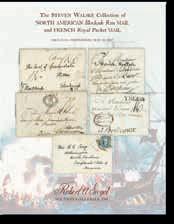
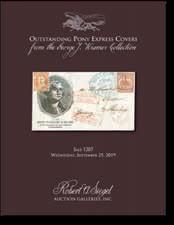
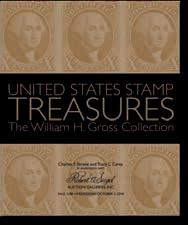

KramerGrossMooz
Siegel offers unparalleled expertise, a worldwide client base, financial reliability, intelligent marketing, and the best internet resources of any philatelic auction house. Contact us today to learn more about consigning with Siegel and ensuring your legacy.

21 West 38th Street, 7th Floor New York, N.Y. 10018 Phone (212) 753-6421 Email: stamps@siegelauctions.com Great Collections have
NAME in common
ONE
BleckwennEubanksWalske
---•..-a.-. -Tll~&."-Aa"UII _.,uXM,...,,.. ".,..
1930
ROBERT A. SIEGEL AUCTION GALLERIES, INC. America's premier stamp auctionee r since



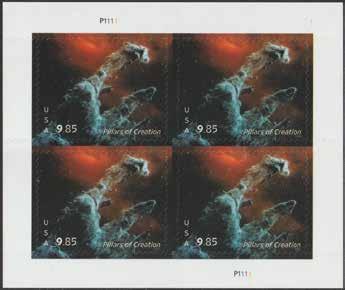

140 THE UNITED STATES SPECIALIST
by
USSS #7335 | m westhome1@aol.com Plate Number Report
compiled
Kim D. Johnson
LL
2r x 4c 1,2,3,4,5,6,7,8*
#????
Love P111 UL UR
LR
#???? $9.85 Pillars of Creation
1r x 6c 1,2,4
P1111
UL ‡ ‡ LR
#???? $30.45 Cosmic Cliffs
1r x 6c 4 3 3 3 + + + t :'4 :'4 :, ) + "'Y ·y 1. 9 ., 9 :'4 :'4 ,) ) ..v ·y '· • Q 9 .. , .,,, + '"'
P1111
UL ‡ ‡ LR


3 #???? Constance Baker Motley

COORDINATORS: Members are invited to report their findings to the appropriate coordinator.
All issues through 1980
Sheet stamps after 1980
Kim D. Johnson
310 E N 3rd Street
Georgetown, IL 61846
Jim Cochrane
P.O. Box 2009
Great Bend, KS 67530
Coil stamps after 1980
Booklet stamps after 1980
Jill Ambrose PO Box 54622
Cincinati, OH 45254
Michael O. Perry
P.O. Box 1194
Rainier, OR 97048
This monthly report is used to update the Durland Standard Plate Number Catalog.
MARCH 2024 141
#???? Year of the Dragon
B111111 ‡ ‡ LL LR 2r x 2c 1,2,3,4*
P11111 ‡ ‡ LL LR 3r x 2c 1,3,4,5,6*
~--'11~ \Lt~ ~ - '11~ ~ --'11~ \lt..Jt f .':/ ·'1 \': ..'l .':/ l J • ffMC.,"'loe,.~IIW'I a ,. n,u,;;11 l'OOl.11• * * ij \Lt~ ~ - '11~ ...'11~ \Lt • ij -l t ( ,r.,..tu ,. • (I .l f lA l" 00C. * '• • * • 11 !ocA~ NEW f[..t.i. W~li' i.1..y/j~ LuN ~c\,\·VUJ I _NAJtfrE'n' 'f!AR ' l ' l ! ti 1 11 11 1 ,1.., t0tht1.•~ J« ..,.. l't: Ofnlflo.'l .. .. r,, , .. ..
3
17527
17528
17529

Report of the Executive Secretary
Michael Brookbank, Mitchell, SD
Tony Barnett, Auburn, WA
Mike Rogowski, Macomb, MI
17530 Don MacLauchlan, Davidsonville MD
17531 Jamie Yakes, Allentown, NJ
17532
Marlonn Baker, Laurelton, NY
17533 Kevin Dudley, Arlington, VA
17534
Dane Claussen, Silver Spring, MD
APPLICATIONS PENDING
17518–17526
NEW MEMBERS
17512–17517
REINSTATED
16312
Richard Bajenski
RESIGNED
7192
9890
11705
16645
16708
Jon Jungman
Gary Showalter
Norman Vachowiak
Steve Lejcher
Colin Beech
16840 Brian McInturff
16875 Peter Schwartz
16976
17232
Richard Lohman
Nicholas Goede
17273 Steven Walske
17321 Barry Silverberg
17327
17412
Steve Davis
Tom Moody
6649
8678
9574
9830
10172
10271
10374
10996
11024
11222
11324
12241
12521
13054
13085
DROPPED (non-payment of dues)
William J. Brya
Dr. Michael Rosenthal
John F. O’Keeffe
Frederick Frelinghuysen
Michael Aronson
Tyson T. Travis
Wilfred J. Butterfield
John P. Greenwood DDS
George L. Young
Wallace A. Craig
Joseph A. Rickards Jr.
Gregory L. Fullerton
William Knopp
David M. Six
Janet M. Gillis
14371 Mauro M. Martinez
14490
14558
14721
14751
15095
15202
15267
15381
15492
15937
16004
16056
16172
16215
16225
Alan E. Cohen
Charles E. Miller
Kent M. Wilson
David St. Maurice
Edward Silver
Samuel D. Hatcher
Thomas J. McLaughlin M.D.
Harold Olsen
Brad Lee Steinberg
Warren L. Kellner
Ronald J. Stauber
James W. Collins
Sylvester Cooks
William Kelly
Edmund A. Hamburger
16233 Robert Parkin
16331 K arlpeter Zitz
16337
James E. Sneed
142 THE UNITED STATES SPECIALIST
APPLICATIONS RECEIVED FOR JANUARY 2024
16339 James J. Semones
16408 Jeff Higley
16469 John W. Carbone
16493 Donald F. Dreisbach
16551 Francis J. Crown, Jr.
16557 Lloyd Hogg
16609 Donald Mackintosh
16617 Thomas Wiesner
16622 Jeffrey Davidson
16640 Stephen Nadler
16728 Martin Feldberg
16777 Gary Rauch
16818 Michael Amer
16828 Dennis De Bruhl
16829 Kelly Markel
16877 Peter Brown
16891 Lee M. Buchanan
16894
Thomas Carboy
16901 Douglas Jehle
16902 John Schwartz
17015 Henry Hein
17019 David Eash
17029
Brian Selkow
17095 Michael Granberg
17103 Ed McKenzie
17120
17123
Bj Slusarczyk
Mark Swan
17131 Steven Bell
17157 Walter Taylor
17211 Michael DelloIacono
17246
Scott Leigh
17287 Daniel Kosko
17317 Christopher J. Putney
17319
Emory Sanders
17362 Chuck Courville
17391 David Smet
17398 Douglas Chapman
17400
17464 William Phillips
17468 Brian Amos
17476 Mark Albright
17482 Walter Muntzenberger
17485 Emily Chesler
17487 Mike Shofner
17488 Dave Aldrich
17490
Helen Lampman
17492 Debbie Vilage
17497 Kent Sinson
DECEASED
5816 McClellan Blair
12199 Joann Lenz
12966 Alan Thomson
16347 Alfred F. Fleury
17281 Michael Simon
Reinstatement?
Every year some members, unintentionally, forget to renew their membership. No problem! If you did not intend to drop your membership, reinstatement is easy online at: usstamps.org/renew or send $25 to USSS, PO Box 1602, Hockessin, DE 19707-5602.
2024 143
MARCH
Hayward 17411 Duane M Thompson 17416 Don Pauley 17418 Sean Crane 17420 Eugene Bruder 17423 Julia Cohen 17432 Gregg Redner 17447 Frank Jamison 17456 Garrett Carlson 17458 John O. Vetter
Harold
TOTAL MEMBERSHIP December 31, 2023 1440 ADDITIONS: New members 6 Reinstated 1 Total + 7 SUBTRACTIONS: Resigned 13 Deceased 5 Dropped 91 Total - 109 NET CHANGE - 102 TOTAL MEMBERSHIP January 31, 2024 1338
Classified Advertising
ABOUT CLASSIFIED ADVERTISING
USSS MEMBERS are entitled to two free ads of up to 40 words each year. Other ads are 10 cents a word, payable in advance. For six insertions, take a 5 percent discount; for 12 insertions, take a 10 percent discount. Ads with [1129] at the end expire with this issue. Make checks payable to USSS. Send copy and check to The United States Specialist, 9038 E. 25 th Dr., Denver CO 80238. Free member ads can be emailed to: editor@usstamps.org
WANTED
BUYING IMPERF FARLEYS WITH GUM. All offers welcome! Frank P Geiger Senior - APS Life since 1968 and ASDA since 1974. Phone: 787689-6879 – FrankPGeigerSr@gmail.com – PO Box 3442 – Pinehurst, NC 28374. [1138]
WANTED – PAYING TOP DOLLAR FOR C-13, C-14 and C-15 singles, both mint/used. Also interested in multiples, flight covers, Zeppelinrelated posters, advertisements, etc. Graf Zeppelin specialist. Rob Lehmann email: diecasttoys@ yahoo.com or call: 240-422-0118. [1150]
W ANTED TO BUY: 1936 TEXAS Centennial Scott 776 FDCs. Please reply to: RonWest76@hotmail.com with description/ images. [1129]
WANTED - 30C GLOBE (C-24) POSTAL history. Unusual destinations, routings, rates, censorship, suspension; through December 1942. Scans, info, and prices to Louis Fiset email: lfiset@outlook.com [1129]
SPECIAL DELIVERY E15 USES WITH $2.00 & $5.00 stamps on cover or tag. No Zep uses! Send info & price to specialdelivery351@yahoo. com [1130]
$1 EUGENE O’NEILL (SCOTT 1294, 1305C) postal history wanted. Unusual uses and foreign destinations highly desired. Chad Snee, Box 838 Troy , OH 45373. suppousnr@yahoo.com [1129]
SEPT. 2, 1945 TOKYO BAY SURRENDER postal history wanted. Covers dated Sept. 2 with original contents highly desired. Chad Snee, Box 838 Troy , OH 45373. suppousnr@yahoo.com [1129]
WANTED: SCOTT 1187 (REMINGTON) photo essays, announcements, promotional items, EFOs, rare FDCs, unusual usages or destinations. Larry Ballantyne, email: LBallantyne@att.net [1129]
WANTED: SCOTT 1146 (WINTER Olympics) announcements, promotional items, EFOs, rare FDCs, unusual usages or destinations. Larry Ballantyne, email: LBallantyne@att.net [1129]
WANTED: COMMERCIAL COVERS WITH US 2893 (5¢) G coil affixed. Also, commercial usages of U092 39¢ official envelope, U093 41¢ official envelope, and U094 42¢ official envelope. Rob Washburn, P.O. Box 840, Skowhegan, ME 04976. Email: stamps@ beeline-online.net [1130]
WANTED: COVERS WITH PERIOD USE OF US #1279 Albert Gallatin. Please email images and prices to ecjensen52@gmail.com. [1130]
WANTED: SCOTT 526 ON COVER without private perforations. Also other offset Washington-Franklin head material (Scott 525536). Andrew Kelley, stamps@andrewkelley. net. [1130]
144 THE UNITED STATES SPECIALIST
Precancel Stamp Society Interested in Learning More about Precancels? Request a copy of “Th e ABCs of Precancel Collecting” and also receive a sample copy of the PSS Forum, the Precancel Stamp Society’s monthly journal. Contact: Frank Bird III, 1095 Pinellas Point Dr South, Apt 352, St. Petersburg, FL 33705-6377. Email: promo@precancels.com. American Plate Number Single Society (www.apnss.org) 103 Barney’s Stamps (www.barneysstamps.com) ................................. 109 Compendium of Plate Number Snippets (by Alan Thomson) 100 Mountainside Stamps, Coins and Currency (www.mountainsidestampsandcoins.com) ....... 109 Precancel Stamp Society (www.precancels.com)......................................... 144 Robert A. Siegel Auction Galleries (www.siegelauctions.com) .................................. 139 Scott A. Shaulis (www.shaulisstamps.com) 126 U.S. Philatelic Classics Society (www.uspcs.org) .................................................... 114 United States Stamp Society (www.usstamps.org)....................................... Covers Index of Advertisers

United States Possessions: Postage Due Stamps and Covers presents the story of Postage Due stamps used in the major possessions or territories of the United States. Written from a stamp collector’s perspective, the authors address the challenge of identifying the myriad of Possession Postage Due stamps by concentrating on stamp identification while also covering the Postage Due issues of Cuba, the Danish West Indies, Puerto Rico, the Panama Canal Zone, the Philippines and more.
In addition to the text, the monograph contains over 300 illustrations and five appendices which provide information to supplement and further explain key points. In many cases, the information presented is new or, if previously reported, organized in a new manner to help the reader understand the complexity of the Possession Postage Dues.
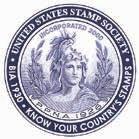
United States Possessions: Postage Due Stamps and Covers
Hard cover, 352 pages, 6-in x 9-in.
Member Price: $39 U.S. postpaid Non-Member Price: $43 U.S. postpaid
Purchased online at: www.usstamps.org/store/ or by mail to: Executive Secretary, P.O. Box 1602, Hockessin, DE 19707-5602
\[., ,J ;':u _ ,~ 'l"""" ,l. ~-'4~~
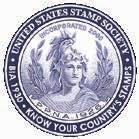

2020 Durland Standard Plate Number Catalog
The 2020 edition the Durland Standard Plate Number Catalog provides the most comprehensive research source for plate number information on United States postage and revenue stamps, including tax-paid revenue stamps, with listings for overprinted Possessions postage, Allied Military government stamps and other back-of-the-book stamps, dummy and test stamps, MDI "Blue Cover" booklets and partial plate numbers on booklet and coil stamps.
2020 Edition of the Durland Standard Plate Number Catalog
448 pages available in Perfect Bound or Spiral Bound format.
Member Price: $26 U.S. plus shipping Non-Member Price: $30 U.S. plus shipping
Purchased online at: www.usstamps.org/store/ or by mail to: Executive Secretary, P.O. Box 1602, Hockessin, DE 19707-5602.
Order Online at: www.usstamps.org/store
UNITED STATES STAMP SOCIETY P.O. BOX 1602 HOCKESSIN, DE 19707-5602 03-2024
United States Stamp Society







 Harry K. Charles, Jr.
Edited by Rodney A. Juell, Lynn R. Batdorf and Steven J. Rod
Harry K. Charles, Jr.
Edited by Rodney A. Juell, Lynn R. Batdorf and Steven J. Rod


















 by
A. Juell
by
A. Juell
































 DO NALD F LYBARGER
DO NALD F LYBARGER
























